The Aviator (PG-13)
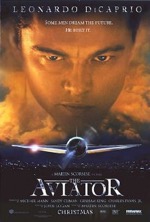
Starring: Leonardo DiCaprio
December 2004
“A Modest Triumph in Retro-Cinema”
The Aviator is finely mounted, well crafted and star-studded, but it fails to attain its desired status as modern epic. Martin Scorsese and Leonardo DiCaprio have reunited (Gangs of New York), presenting a soaring biopic of billionaire, industrialist and playboy, Howard Hughes. There’s no doubting the skill set of every person in every department that toiled on this film or the talent of the vast array of A-list actors that appear here, and yet, there’s still something lacking.
Perhaps it’s a matter of identification: how many of us have experienced the pressures of being a billionaire or struggled with the extreme mental aberrations Hughes dealt with on a daily basis? Perhaps it’s the preponderance of narrative or the scarcity of action sequences? Perhaps its film’s length—The Aviator weighs in at three hours and five minutes—or some other, intangible, factor.
Whatever the reason, the movie succeeds as a work of art, but fails to entertain in any significant way: when Hughes repeats “The wave of the future” like a skipping CD right before the final fade, have we really been impacted on an emotional level or do we just pity the man in the mirror?
DiCaprio does a superb job of bringing Hughes’ passions, foibles and eccentricities to life and Cate Blanchett turns in a marvelous performance as Katherine Hepburn: their best scenes together are the golf game, Hughes teaching Hepburn how to fly, the meet the parents debacle and their fulminating breakup. Two foils for Hughes in the movie (other than his O.C.D. and fits of hypochondria) are Juan Trippe (Alec Baldwin), owner of rival Pan Am Airlines and Senator Brewster (Alan Alda in an Oscar-worthy performance), a crooked politician bent on destroying Hughes in a sure-fire trial that turns into a media circus.
The rest of the cast reads like a SAG roll call: Jude Law (as Errol Flynn), Kate Beckinsale (as Eva Gardner), Gwen Stefani (as Jean Harlow), John C. Reilly, Edward Herrmann, Willem Dafoe, Ian Holm, Brent Spiner, the list goes on and on.
I have to admit that The Aviator is a lavish spectacle featuring a powerfully moving, human story, but its sheer size and power left me a little overwhelmed—it’s so overstuffed and top heavy that it collapses under its own weight. All the movie’s bells and whistles seem to cry, “Look at me. Look at what an exceptional film this is.” Some may buy into the movie’s sizzle, but the meat I crave is of a different ilk. In the end, The Aviator has Hughes-sized ambitions that render the film a high-powered oddity.
Rating: 2 1/2
Meet the Fockers (PG-13)
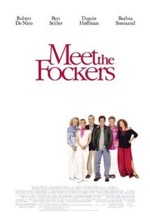
Starring: Ben Stiller
December 2004
“Great Performances Fail to Save Unoriginal Sequel”
The movie opens with a sequence of fortunate events for Greg Focker (Ben Stiller) and Pam Byrnes (Teri Polo)—someone gives up their cab for the couple, all the stoplights turn green for them on their way to the airport, and Greg’s oversized carry-on is taken to the captain’s personal storage locker. Of course, we all know this streak of good luck won’t last for long…and it doesn’t.
Meet the Fockers, the sequel to the popular one-disaster-after-the-next flick, Meet the Parents, is a nothing more than a retelling of the original—the only new element is the addition of Greg’s parents into the dysfunctional mix. Bernie Focker (Dustin Hoffman) is a semi-retired lawyer who sports a dark tan and an array of Hawaiian shirts and his wife, Roz (Barbara Streisand), is a sex therapist for the geriatric set.
Robert DeNiro is back as the stiff and ever-paranoid former C.I.A. agent, Jack Byrnes, and his screen wife, Dina (Blythe Danner) remains the only voice of reason in the midst of calamitous family get-togethers. Greg and the Byrnes’ pile into Jack’s new, state-of-the-art R.V., which is tantamount to a fine motel room on wheels (complete with hidden spy suite), and head to the Focker house in sweltering gator territory. Jack’s grandson from his other daughter joins them on the road trip, and it quickly becomes clear that the only purpose the child serves is to provide a cute face and some comic relief.
If there is a part of the movie that plays well, it’s the friction between Jack and Bernie; from the moment Bernie hugs Jack and pecks him on the cheek, you know it’s going to be a long visit. These fathers—and families—are diametrically opposed when it comes to lifestyles and worldviews and the sparks fly high and often during “family times.” As if things aren’t going rough already, the startling revelation that Pam is pregnant sends both families reeling. Of course, issues are worked out and relationships are mended or built by movie’s end and a humorous wedding wraps up the zany storyline. Owen Wilson reprises his role as Pam’s former fiancé and is the priest that marries the happy couple (Wilson singing in Hebrew is a hoot).
To its own detriment, Meet the Fockers returns to the same well that spawned its predecessor—the Murphy’s Law sequences feel forced and their predictability really detracts from the movie’s intended impact. The film is loaded with crude humor and some scenes are just plain wrong. It’s truly unfortunate that this amazing array of talent was wasted on such pedestrian fare. I guess the most fitting reaction to the movie is right on the poster.
Rating: 2
Flight of the Phoenix (PG-13)
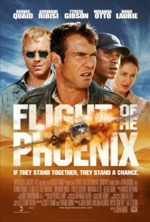
Starring: Dennis Quaid
December 2004
“Like the Plane, Stays Grounded Most of the Time”
What you have here is your basic airplane crash/survival/rebuild the plane story with few original elements and even fewer surprises. A remake of the 1965 movie starring Jimmy Stewart, The Flight of the Phoenix is basically a Dennis Quaid vehicle picture, and even though he turns in his normal, polished performance, it’s still not enough to salvage this floundering premise.
Captain Frank Towns (Quaid) is the cargo plane pilot assigned to pick up the crew and equipment from a recently closed mine in Mongolia. As fate would have it, the mother of all sand storms (al a The Mummy and Hidalgo) assails the craft and violently forces it off course. The best effect in the film shows the left propeller spinning forward off its mount and slicing into the metallic hull just behind the cockpit. After an intense crash sequence, the survivors are faced with a dire tableau; the plane is half buried in the ubiquitous sands of the Gobi desert. To make matters worse, their water reserves and supplies are frighteningly low and the desert heat is unbearable.
Somewhere along the way, they decide to rebuild the plane with the guidance of weasel-eyed Elliot (Giovanni Ribinsi from Sky Captain and the World of Tomorrow). To add spice to the manual labor section of the film is an electrical storm, a mutiny and a run-in with the local nomads.
The only part of the movie that had real potential was the conflict between Frank and Elliot, who develops a God complex: after all, he knows how to build planes (toy model planes, it’s later discovered), and immediately takes to ordering everyone around. The most gratifying scene in the movie is when Frank hauls off and knocks Elliot on his butt. That scene, the Clinton-style pre-flight check and a few other random jokes are the only elements that make the movie even remotely memorable.
The movie’s resolution is particularly predictable and ends much too abruptly. So much is left unresolved in the film, like, how much gas do they have? And, are they going to fly all the way strapped onto the wings (and wouldn’t four people on one wing and two on the other imbalance the jury-rigged plane?). And are they going to kill Elliot when they get back or just loosen his straps and let gravity do the job? Actually, that would make for a more interesting story than the one presented here. The Flight of the Phoenix is one movie that shouldn’t have been resurrected from the ash heap.
Rating: 2 1/2
Ocean’s Twelve (PG-13)
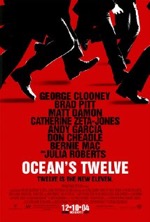
Starring: George Clooney
December 2004
“A Lot Less, Even with One More”
The long-awaited follow-up to 2001’s stylish smash-hit, Ocean’s Eleven, features the same cast as the earlier film, plus Catherine Zeta-Jones, and is helmed, again, by Steven Soderbergh. The question that always arises with a sequel is: “Is it as good as the first?” Answer: Ocean’s Twelve fails to equal, much less surpass, its modern predecessor. Here’s a rare exception in scriptwriting, where too much plot is actually an impediment to the movie’s entertainment value.
Soderbergh has toned down the flashy editing style displayed in Ocean’s Eleven (which employed a variety of wipes, quick cuts and multiple/moving frame shots), but here, the disjointed storyline has nearly the same effect. How do you take an average script and make it seem more complex? Present it in a non-linear fashion! It worked for the first film, so why not try it again? This time around the narrative sleight of hand doesn’t work, because the audience is ready for it. Also, the movie is saturated with technical jargon from the thieving handbook, which comes off as gibberish to the average viewer not educated in criminology.
Ocean’s Twelve ambles along on cruise control for most of the movie and introduces very few new characters or situations. It’s almost as if the producers thought, “Shoot the picture in some amazing European locations, have the preponderance of A-list actors pull off another mind-blowing heist and audiences will love it.” Guess again! Character development is appallingly shallow in the film; the writers just expect us to know everything about these people from the first film and only make cursory attempts at reacquainting us with or expanding our knowledge of these characters in any meaningful way.
The movie makes some significant missteps near the climax: the Tess Ocean (Julia Roberts) playing Julia Roberts sequence is inane, as is Bruce Willis’ zany cameo (let’s add one more luminary to the film, because we’re not quite sure we have enough star-power). Saul (Carl Reiner), the potential wildcard, shows up to save the day, but is promptly thrown into jail with the rest of the incarcerated cast. Vincent Cassel’s villain, Night Fox, is a worthy, if under-developed adversary, but his dance through the lasers is simply a fast forward version of the one seen in Entrapment. And finally, the reunion between Zeta-Jones’ character and her thieving father feels contrived and lacks emotional punch.
Ocean’s Twelve is devoid of the light-hearted synergy that Ocean’s Eleven had in spades. Where’s the fun? Where’s the humor? The bottom line: Ocean’s Twelve would have been twice as enjoyable if it had been half as confusing.
Rating: 2
Finding Neverland (PG)
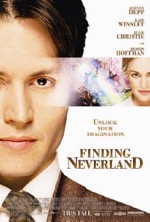
Starring: Johnny Depp
November 2004
“Magical Retelling of Tired Tale”
Based on the real life trials and successes of playwright, J.M. Barrie, the visionary who brought us Peter Pan, Finding Neverland is a moving film, rich in character and imagination. Finding Neverland is pure drama, so viewers looking for anything else will be sorely disappointed (like those two, giggly teenage girls who sat right behind me). The movie really delivers emotionally, revealing the human condition at its best and worst—its brightest and darkest.
Johnny Depp (Pirates of the Caribbean) is brilliant as Barrie and pulls off a surprisingly authentic Scottish brogue. Showcasing his expansive range, Depp masterfully reveals just how adept he is at being serious or silly and how skillfully he can morph from one into the other.
In the midst of a failing marriage, mediocre theater attendance and scathing reviews for his plays, Barrie escaped into the realms of his fertile imagination and created Neverland, a magical world, but what’s more, a guiding philosophy for his life. It’s this philosophy of optimism that anchors Barrie during the storms that incessantly assail him…the theater owner (a very un-Hook-like Dustin Hoffman) is pressuring him to produce a hit, his wife leaves him for another man, rumors of inappropriate activity surround his friendship with the newly widowed Sylvia Davies (Kate Winslet) and her four sons (two of them named Michael and Peter), the palpable disdain and disapproval he receives from Sylvia’s controlling mother (Julie Christy) and Sylvia’s untimely death from an unknown disease.
Winslet plays the beleaguered-but-not-showing-it single mother to the hilt; Barrie is a breath of fresh air to her lonely life, a touch of freedom and spontaneity to banish the doldrums of her regulated existence. The Davies children were excellently cast; their appearance, accents and attitudes are appropriate to the milieu and add to the movie’s emotional impact in small, but crucial ways…especially tenderhearted, teary-eyed Peter.
Dustin Hoffman’s appearances are infrequent, but his portrayal of the laconic theater owner is touching in an impersonal way—he genuinely believes in Barrie’s talent and is willing to put his money, reputation and career on the line for the young playwright. Together, they’re a potent team: one has the vision to fill theater seats and the other has a driving passion to fill people’s hearts with adventure and wonderment.
This account depicts Barrie as the quintessential gentleman, and the movie, itself, is a gentle thunder that doesn’t “wow” you, but has a lingering quality that lasts long after you’ve left the theater. Finding Neverland is magical cinema that transports the viewer to a place of hope and beauty that resides somewhere between our hearts and the second star to the right.
Rating: 3
National Treasure (PG)
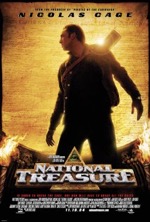
Starring: Nicholas Cage
November 2004
“One Man’s Treasure is Another Man’s Junk”
After getting past the preposterous notion that is the storyline of National Treasure, and after suspending my disbelief of the movie’s unfounded historical assertions and unrelenting contrivances, I actually found this Jerry Bruckheimer produced film to be modestly entertaining—in a “pass me the popcorn” sense. National Treasure surpassed my expectations and that’s largely due to the fact that the movie didn’t take itself too seriously, but rather, elevated the flimsy premise with fine performances and well-paced directing by Jon Turteltaub.
The first clue is discovered on an ice-entombed sailing ship in the Antarctic named “The Charlotte.” The rest of the clues involve Benjamin Franklin’s supposed secret writings and inventions and the Declaration of Independence (an invisible map inhabits the backside of the sacred document). What ensues is a present day Raiders of the Lost Ark romp, where the characters find and assemble clues in a multi-generational effort to discover a “spectacular” treasure that’s been collected and protected for centuries by the mysterious Freemasons—the earliest pieces span back to ancient Egypt.
Nicholas Cage (who plays lead character, Benjamin Franklin Gates) is a bit stiff at times, but his makeshift team, consisting of Abigail Chase (Diane Kruger) and Riley Poole (Justin Bartha), compensates for the actor’s deficiencies in compassion and comic relief. Cage cuts a confident figure as the adventurous treasure-seeker, but despite his best efforts to pull off the part of an action star, he still doesn’t hold a torch to Harrison Ford’s Indiana Jones (who could?).
Sean Bean, as Gates’ former partner turned chief adversary, Ian Howe, adequately portrays the “heavy,” but he was much better as the I.R.A. hit man in Patriot Games (another Ford connection). Playing Gates’ jaded father, Patrick, is Jon Voit, whose glorified cameo serves as the only voice of reason to his screen son’s wild leaps of logic and knee-jerk decisions. Brief appearances by Christopher Plummer and Harvey Keitel also pepper the movie; the former plays Gates’ grandfather and the later is the federal agent bent on capturing Gates and reacquiring the stolen Declaration of Independence.
National Treasure is action/adventure light: its like James Bond without any vices—no sex, no swearing and very little violence. The movie will doubtlessly seem insipid to hard-core action fans, but what the movie looses in S.W.M. viewers, it will undoubtedly more than recoup with younger viewers and whole families. Verdict: the movie’s appeal is extremely subjective—the audience will either discover a treasure trove or an empty chest.
Rating: 2 1/2
The Polar Express (G)
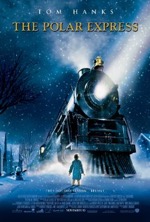
Starring: Tom Hanks
November 2004
“Warm at the Core…Icy Around the Edges”
Robert Zemeckis and Tom Hanks are back together again, changing venues from a deserted Pacific island to the frozen wasteland of the North Pole. Based on the Caldecott award-winning children’s book by Chris Van Allsburg, The Polar Express is an uplifting tale about a magical train that whisks selected children off to the North Pole for a visit with Jolly Ole Saint Nick.
Even from the jaw-dropping trailer, it was clear that The Polar Express would be the next iteration in computer-animated films. The movie is visually stunning (especially in IMAX 3-D), more so for virtual landscapes and breakneck action sequences than for the waxwork visages that make the characters appear too perfect.
Tom Hanks, again, asserts his range by playing/voicing five different characters in the film. Even with so much involvement, however, he’s still upstaged by the arduous and twist-riddled journey and by the train itself—the unsung hero of the movie.
The Polar Express, a feel-good story of friendship and courage, where warm fuzzies fly like arctic snowflakes, will undoubtedly be ushered into the halls of modern Holiday classics, but despite the enormous positive energy that surrounds it (almost like a cosmic aura), the film fails in several key areas.
The most obvious detractor is the simplicity of the plot and the straightforward manner in which the story is presented (granted the source material is a picture book for kids). I’m not spoiling anything when I say the majority of the movie takes place on the train; either going to or returning from the North Pole. Besides a wisp of character development here or there, the only element that lends the movie any kind of synergy is a series of adventures the train passengers have along the way. These mishaps, though engaging and exhilarating, are the only thing that holds the plot together.
Take, for instance, the young girl’s lost ticket that quickly becomes a silent seminar in Murphy’s Law. Although not nearly as exhausting as the sports almanac gimmick in Back to the Future 2 (also helmed by Zemeckis), the ticket’s flight and plight is still far-fetched and overplayed. If deja vu sets in while watching the dizzying POV sequence, it’s because you have, indeed, seen it before—not with a ticket, but with a feather (Forrest Gump—yup, Zemeckis again).
Is anyone else bothered by the fact that none of the characters have hot breath billowing out of their mouths? Or that the children, seemingly unaffected by the gelid night air, walk around in their pajamas and never once shiver? These trifling details, however, are small grievances next to the movie’s insidious ability to pull at the heartstrings with a well-worded phrase or a well-timed song. Though finely-crafted, the movie’s songs were strategically placed to produce the maximum number of tears, but the foisted emotions quickly fade when the final image of the nearly-deified, silver sleigh bell fades to black.
The Polar Express has some magical moments, but, if you’re unaffected by its unbridled emotionalism, it’ll leave you out in the cold. Some will feel richer for having completed the journey; others will feel like they’ve been taken for a ride.
Rating: 2 1/2
The Incredibles (PG)
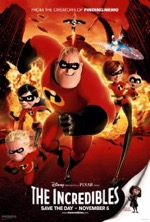
Starring: Craig T. Nelson
November 2004
“Supercharged Thrill-ride That Lives Up to Its Name”
Finally…a movie that lives up to its boastful title! The Incredibles is the first Pixar animated feature to focus on “real” people; straying from toys, monsters and fish, the company took a huge risk, and delivered in a BIG way.
At first glance, a family that refuses to use their superpowers for fear of public scorn sets up a dubious premise, but fortunately, near the movie’s mid-point, Pixar’s renowned penchant for fun, frivolity and frenetically fast-paced action sequences kicks into high gear. Forced back into service by the dastardly deeds of Syndrome (Jason Lee), techno-villain and former fan boy who was jilted by Mr. Incredible (Craig T. Nelson) years earlier, the family of four (and a half) lands in the middle of one misadventure after the next. Saving dad is the first order of business and the second is stopping Syndrome and his colossal beach ball shaped robot tanks from wreaking havoc on the city (a la Sky Captain and the World of Tomorrow, and seemingly every other serial tale or comic book ever written).
The word that best describes The Incredibles is “creative,” and two factors that have forged the movie into an instant classic are: 1. As we’ve discovered in recent years, it’s all about strong narrative and fully realized characters, not eye-popping special effects (although, effects can be a valuable aid as long as they don’t supplant the story, i.e.: The Lord of the Rings trilogy). The humanity of the characters and their “abnormal” challenges makes for entertaining family fare: the fight at the dinner table is a hoot. Talk about dysfunctional! 2. Like any good piece of music, the movie has dynamics. It doesn’t peak too soon, but is paced to perfection, gradually building in suspense, peril and guffaws.
The Incredibles isn’t an outright comedy, but the situations the Parr family finds themselves in are absolutely hilarious. My personal favorites: Elastigirl (Holly Hunter) reconfigures herself into a rubber raft, while son (and Flash rip-off), Dash (Spencer Fox) becomes an off-board motor, and the sequence where Elastigirl is pinched into four different sections by two closed doors. The more the Incredibles discover new applications for their superpowers, individually and collectively, the more amusing the movie becomes and, ironically (or by design), the more power they exert over us. Case in point: Iceman wannabe, Frozone (Samuel L. Jackson), whose name alone made me chuckle for five minutes straight.
Lampooning superhero stereotypes isn’t the only thing The Incredibles does well (the cape gag was uproariously funny); family matters are at the core of the story, which drives home teamwork, courage, loyalty and the importance of having a great outfit designer.
The only downside to The Incredibles is that it runs ten minutes too long—this has to be the first two-hour animated feature (including the brilliant Jackalope short). The Incredibles is admittedly campy, but it’s also an exhilarating romp. One could even say it’s in…
Parting thought: With a similar array of superpowers, has this movie stolen any thunder from next summer’s The Fantastic Four?
Rating: 3
Ray (PG-13)
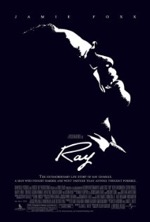
Starring: Jamie Foxx
October 2004
“Touching Tale Leaves Ray on Our Mind”
Ray Charles was one of the greatest singer/songwriters of our time. He was also a womanizer and a heroine addict. To its credit, Ray doesn’t gloss over these sordid details but exposes them for what they were…every star has foibles.
The movie begins with Ray getting on a bus and heading out to join a band in Seattle. As his career progresses, so does his back-story, which is revealed a chapter at a time in dreamy flashback sequences.
Reared in veritable poverty—in a sweltering Florida slum—Ray Charles had a fairly happy childhood playing games with his kid brother and terrorizing his hardworking mother. One day, Ray’s brother, while playing near a brimming washtub, slipped and drowned. Ray could have prevented the tragedy, but he just stood there, completely frozen in the oppressive heat. He blamed himself for decades after the incident, and his guilt created the pattern of self-destructive behavior that plagued him for most of his adult life.
Another retrospective segment reveals the time when Ray’s vision began to worsen. One of the most powerful scenes in the movie depicts the agony his mother endured as she resisted the urge to help Ray navigate around the various obstacles in their house. His mother instilled in Ray a dogged resolve, warning him that no one would pity him because of his handicap and that he needed to stand on his own two feet.
Ray took those words to heart by accepting small-time gigs and eventually working his way up to touring with a band and finally becoming a solo artist. Ray’s business sense served him in good stead (he required payment in dollar bills), as did his ability to negotiate (he once charmed his way into retaining his masters).
The story is a tragedy, but also a triumph; and after enduring a tumultuous season in rehab., Ray never went back to drugs. Also, he was honored by the state that had previously banned him when that state adopted “Georgia on My Mind” as its state song.
Jamie Foxx’s portrayal of Ray Charles is simply astounding; he comes as close as anyone ever has as to perfectly capturing the nuances and soul of the real-life person they’re playing. An Oscar nod for Foxx is a foregone conclusion—his performance is a revelation of Herculean proportions (and I don’t suppose it hurt that Foxx had the opportunity to meet and study the music legend before his untimely passing earlier this year).
Regina King, who plays Ray’s feisty paramour, excels as a triple-threat fly girl; she stands out as the only supporting character that holds her own against Foxx’s overpowering performance.
Ray is an emotional journey that takes the high road of veracity in a market replete with embellished versions of “true stories.” We miss you already, Ray.
Rating: 3
Ladder 49 (PG-13)
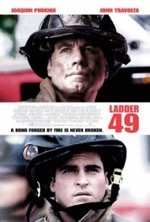
Starring: Joaquin Phoenix
October 2004
“Moving Tribute to Fallen Heroes”
We’ve had our share of movies like Backdraft and Frequency, but Ladder 49 is a different breed of firefighter film. Not to take anything away from the character development or emotional impact of those other films, but Ladder 49, to an even greater degree, reveals the often gritty and grim profession that firefighting can be, while also humanizing the characters…showing them at their best and worst.
Joaquin Phoenix is fast becoming one of Hollywood’s most promising up-and-coming stars. Fresh off his turn as a hapless victim in M. Night Shyamalan’s The Village, Phoenix has taken on a different kind of role this time around—the everyday man.
As the movie unfolds, Phoenix’s character, Jack Morrison, has fallen down several stories inside a fire-enveloped building. As he’s lying in rubble and inhaling stifling smoke, Jack begins to ruminate on his life and the events that brought him to this place. What ensues is a series of flashbacks that flesh-out Jack’s back-story: his first day as a firefighter, the day he met his future wife, the day they married, the day he learned he was going to be a father, the day he lost a friend in a fire, etc. And that’s the gist of the plot…pretty straightforward.
Even though Ladder 49 has some TV drama qualities, the ingredient that prevents the story from degenerating into a documentary on firefighting is the relationships between the firefighters and their unique way of dealing with work-related stress. The “initiation” scenes are some of the most memorable in the movie, as are the extreme pranks they pull on each other: the goose in the locker and the “baby shower” are two prime examples. Running jokes like Lenny Richter’s (Robert Patrick) admission that he’s getting too old for the job also lighten the mood in what ends up being a pretty somber tale.
John Travolta’s presence as fire chief Mike Kennedy isn’t felt very strongly in the film, but his character’s leadership and guidance is: besides his two-hanky speech at the end of the movie, his best monologue comes when his team nearly breaks down (and nearly breaks each other’s skulls) after the death of a fellow firefighter. With great conviction, and perhaps a few too many expletives, he gives his despondent and blame-seeking team a swift kick and tells them to get back on the horse…er, engine.
Newcomer, Jacinda Barrett, turns in a touching performance as Jack’s reserved wife: the expression on her face when she sees her greatest fear through the kitchen window stands out as one of the movie’s most unforgettable scenes.
Despite a fairly predictable plot, Ladder 49 succeeds in paying tribute to the men and women who risk their lives every day to protect the citizens of this country from life-threatening infernos. The story portrays firefighters less as heroes and more like real people who care for the welfare of others, and in this age of average Joe’s and reality shows, this aspect of the movie should really resonate with the masses.
If Ladder 49 does have a flaw, it’s that the firefighters respond to one too may fires (we get the idea already—this line of work is dangerous). But, ultimately, the movie is about people, not fires, and how we deal with life and death, triumph and tragedy. Ladder 49 is one of those rare movies that entertains, but also inspires: the sad, yet uplifting dénouement reveals a degree of panache sadly missing from most scripts these days.
Rating: 3
The Forgotten (PG-13)
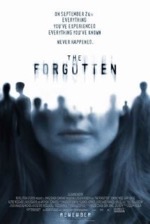
Starring: Julianne Moore
September 2004
“Solid Start, Forgettable Ending”
For three quarters of the movie, I was utterly gripped by the intriguing scenario and rampant paranoia that courses through this unconventional thriller. The film is made even more powerful by believable performances from Julianne Moore, Gary Sinise, Anthony Edwards and Alfre Woodard. Unfortunately, acting is the only element that is believable in the movie, as the story takes a significant left turn near the coda, destroying any momentum established in earlier acts.
Telly Paretta (Moore) lost her pre-teen son, Sam, in a plane crash and hasn’t been able to move past said traumatic event ever since that fateful day. Her memory of her son hasn’t faded one iota since his passing, but every item (picture, articles of clothing, etc.) of Sam’s has begun vanishing…one piece at a time. She accuses her husband (Edwards) and her shrink (Sinise) of conspiring to erase all traces of Sam’s former life. According to the two men, Telly never had a son, a revelation that becomes even more disturbing when she finds no records of the plane crash at her local library. Telly confronts her neighbor, a middle-aged drunk (Dominic West) and helps him remember his daughter that was also on the same plane. Together, Telly and her newfound friend seek to uncover this sinister plot that’s wiped away all physical evidence of their children’s existence. These events set up an interesting question in the viewer’s mind: is Telly crazy, or is some outside agency seeking to discredit and/or mentally destroy her?
Such an intriguing notion should have led to a riveting climax, but instead, the balloon deflates when an otherworldly twist is introduced into the plot. The children were abducted by aliens? This was all one big experiment to test the depths of the maternal instinct?? Even by its own rules, the “alien” subplot doesn’t hold up under scrutiny. How can aliens—with the ability to abduct a plane full of children, erase people’s memories, “beam” people up to the mother-ship and, indeed, even put events back to the way they were before the incident—be hampered by a time constraint on their test? If they can manipulate time, shouldn’t they be able to run the same test on the same person indefinitely? Time is relative, after all.
Therein lays the problem with The Forgotten. Tough hackneyed, a government conspiracy or scientific cover-up would have been a much more satisfying conclusion to such a solid foundation. Even though the special effects are few, they’re groundbreaking and breathtaking. Those scenes, combined with fine performances are the only things that keep the movie from becoming utterly forgettable.
Rating: 2 1/2
Wimbledon (PG-13)

Starring: Kirsten Dunst
September 2004
“Surprisingly Fresh Sports/Romance Story”
At first glance, a movie with an identity crisis between a sports flick and a love story is a pretty bad thing. On the one hand, you run the risk of loosing male interest to some sappy romance and on the other hand, females not interested in sports will spend their movie money elsewhere. Wimbledon is a balancing act that, somehow, manages to pull off the difficult feat of becoming a successful sports/romance movie.
There are several contributing factors to this winning formula. First, the leads are attractive, intelligent and have great chemistry together. Paul Bettany (Master and Commander) plays Peter Colt, a thirty-something, nearly washed-up tennis player who’s taking his last shot at winning Wimbledon. Bettany imbues Colt with a brand of charisma that’s believable and endearing—his voice-overs, containing his innermost thoughts, really serve to humanize the character and provide an honest and refreshing portrayal of a struggling sports star.
Dunst (Spider-Man) plays Lizzie Bradbury, a serious newcomer to tennis who has a track record of being distracted by men during big tournaments. She falls fast and hard for Colt (the whole tennis connection), and a torrid romance ensues, much to the disapproval of Lizzie’s overprotective father, Dennis (Sam Neill).
The movie’s climax is predictable, yet uplifting; Colt wins Wimbledon, and, after weathering a series of relational storms, wins Lizzie’s heart. Colt retires, but Lizzie will continue pursuing her dream of becoming a champion at Wimbledon. And, as would be required of such a tale, they live happily ever after.
The star’s contribution to the movie cannot be overstated, but several supporting characters aid and abet Bettany in making Wimbledon a crowd pleaser. The aforementioned Dennis Bradbury (Neill) is solid, as is Peter Colt’s fanatical father, Edward (Bernard Hill of The Return of the King), and the young heartthrob Jake Hammond (Austin Nichols), who serves as fellow tennis competitor and underdeveloped antagonist. Also making cameo appearances are John McEnroe and Chris Evert, who provide some additional celebrity and credibility.
As an independent film, Wimbledon is a small release and will most likely not receive the attention its due. It’s a shame, because Wimbledon is a feel-good flick that reaffirms the notion that it’s never too late to achieve in life.
Rating: 2 1/2
Sky Captain and the World of Tomorrow (PG-13)
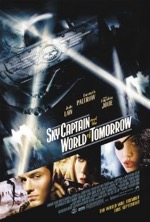
Starring: Gwyneth Paltrow
September 2004
“Long on Title, Short on Plot”
The “1/2” is for a solid cast, overall creativity and the groundbreaking manner in which the movie was filmed. The “two” is for an average tale that is further diluted by props, machines and plot devices that are so farcical and fantastical that they become a huge distraction—even to this reviewer, who can normally suspend his disbelief to the final frontier and beyond.
If Sky Captain and the World of Tomorrow could be distilled into one word it would be “derivative.” The movie borrows from many genre films and borders on plagiarism. Sky Captain (Jude Law) has a dash of Han Solo and a wardrobe similar to Indiana Jones’. And speaking of Indy, Raiders of the Lost Ark rip-offs abound, like the plane flying over the map trick or a fateful trip to the snow-capped mountains of Nepal. The attack on the hangar is suspiciously similar to the one seen in Pearl Harbor. Inside the hanger, as those with a steely eye will observe, is a T.I.E. fighter cockpit from Star Wars. The many plane/ship upgrades are an elaborate tip of the hat to the James Bond movies and the bizarre creatures on the tropical island look like they escaped from Jurassic Park. The robots themselves look like cousins of the Iron Giant and the mechanical, whirring noises they make are like something right out of the sound library from the original War of the Worlds. Also, Dex’s (Giovanni Ribisi) ray gun resembles a Buck Rogers sidearm.
Then there’s the plot. Dr. Totenkopf (canned footage of the late Sir Lawrence Olivier—one of the movie’s only masterstrokes) abducts all of the brilliant scientists previously involved in a top secret project and forces them to create giant robots and other such machines of mass destruction. Totenkopf’s ultimate goal is to create a second ark (rocket ship), which will ferry all of Earth’s animals (plus a few of his own creations) to a new planet, free from the evils of this present world. Trick is, all life on earth will be incinerated when the ship’s rockets burn up our atmosphere—proper judgment for the way we’ve mismanaged the planet. And it’s up to Sky Captain and his Swiss Army plane, along with his bickering partner, Polly Perkins (Gwyneth Paltrow) and his old flame, Franky Cook (Angelina Jolie) to save the day.
Hokey? You bet! And it’s a shame, because the movie features good characters with good dialogue, performed by good actors. The effects are nothing short of amazing and the visual style is moody and unique. If anything holds the movie back it’s the contrived storyline. In the final analysis, Sky Captain and the World of Tomorrow is a brilliant disappointment.
Rating: 2 1/2
AVP: Alien vs. Predator (PG-13)
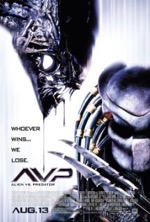
Starring: Sanaa Lathan
August 2004
“Lots of Hype, Not Much Bite”
“Whoever wins, we loose.” The movie’s slogan refers to the humans in the movie, but can just as easily apply to those in the audience…especially if you’ve paid full price. Alien vs. Predator, or AVP, is a lackluster affair that creates a patchwork plot from the highlight reels of the Alien and Predator series. There’s little innovation here, just a few new faces, namely adventurer, Alexa Woods (Sanaa Lathan) and wealthy industrialist, Charles Bishop Weyland (Lance Henriksen) and some updated special effects.
A plot device that runs through both series is that all the secondary characters get thrashed and one main character, somehow, escapes certain death. Be it Sigourney, Ah-nold, or Danny, they all found a way to beat their extra-terrestrial nemeses and in some cases, earned their respect along the way (and in Sigourney’s case, held on just long enough to make a sequel).
AVP’s premise is simple: Weyland discovers an ancient temple beneath the frozen surface in Antarctica. Before his drill team arrives, they discover a shaft has already been cut down to the temple (that should be their first clue to leave the premises). Upon entering the ancient remains, the team learns two valuable bits of information: 1, there’s an Alien hatchery in one of the chambers and 2, the Predators have arrived to do some hunting. The twist: the humans unwittingly steal the Predator’s special weapons, and without them, the Aliens just might be able to defeat the Predators and overrun the earth (oh no).
The story employs a cheesy gimmick (just one, you ask?) with the labyrinthine halls inside the temple; the chambers keep shifting like a giant Rubik’s Cube, separating characters and throwing some right into the path of razor-sharp incisors. The temple reconfigures every ten minutes, which is convenient since that’s the rate at which the humans are being slaughtered. The character development is weak for one reason, the writers don’t want the audience to become too attached, because they’re all gonna’ die anyway.
A motto that’s tossed around too often, and much too frivolously, is, “The enemy of my enemy is my friend.” The Predators have butt-ugly mugs and fight like members of an intergalactic gang, but they do have a code of honor: they won’t kill Weyland because he’s dying of a fatal illness and they show their respect to Woods after she helps kill Big Mama Alien (the trophy ceremony is virtually identical to the one in Predator 2).
Beyond the abysmal plot, there’s nothing redeeming about the movie, save for the brief camaraderie between human and Predator, which brings up an unanswered question: are we friends with the Predators now? Are the Predators getting soft or is it just the screenwriters?
Rating: 2
The Village (PG-13)
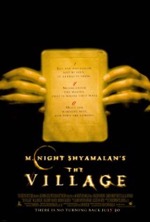
Starring: Sigourney Weaver
July 2004
“It Takes a Village…To Scare You Senseless”
M. Night Shyamalan’s fourth chill-fest is both better and worse than his previous cinematic offerings (The Sixth Sense, Unbreakable and Signs). Shyamalan should be lauded for breaking with his usual formula and milieu, while maintaining strong character vignettes and intensely frightening situations. If possible, his directing here is even tighter than in the earlier trilogy and his clout has surrounded him with a stellar cast this time around—his first ensemble piece.
Joaquin Phoenix is back from Signs, and plays Lucius Hunt, a fearless and laconic young man who has a secret love affair with Ivy (Bryce Dallas Howard, Ron’s daughter). Ivy is the blind daughter of village elder, Edward Walker (William Hurt), a reserved man who speaks in nineteenth century English with interminable pauses in each line. Rounding out the cast is Lucius’ mother, played by Sigourney Weaver and the slow-witted Noah Percy (Adrien Brody), who is also secretly in love with Ivy.
The movie sets up a bit slowly, but strikes a crescendo near the midpoint. It isn’t until about three fourths of the way through that tensions mount and events escalate, paving the way for a nail-biting climax and the patented Shyamalan surprise ending.
With The Village, it’s clear that Shyamalan has moved into the upper echelon of Hollywood directors; his craft is well honed and he evoked excellent performances from his actors, especially Phoenix, Howard and Brody—the twisted ménage a trois. It’s a lot easier to create scary scenes at night, but the lion-share of the frightening scenes in The Village are filmed during the day—right out in the open. This is just another testament to Shyamalan’s directorial prowess (I’m gonna’ film it at day and I’m still gonna’ scare the @*!/ out of ya’).
But a nagging question hovers just this side of the dread-inducing forest, is The Village as good as its predecessors? The answer is no, but it’s still a quality thrill-o-rama. Problem: Shyamalan has painted himself into a corner now that everyone is anticipating a trick ending each outing. His big screen sleight of hand will become exponentially harder to pull off now that the audience has become wise to his styles and tactics (I figured out the twist ending halfway through the movie).
James Newton Howard’s score adds another dimension of creepiness to the movie, as well as some early American-flavored cues. The costumes and sets are exceptionally well crafted and lend the movie another degree of authenticity. So, what have we learned from The Village? Stay away from the bad color, avoid mentioning “those we don’t speak of” and hope for a better movie the next time Shyamalan directs.
Rating: 3
Catwoman (PG-13)
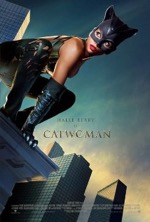
Starring: Halle Berry
July 2004
“Faithless Treatment of Feline Fatale”
I have to admit, Catwoman was a lot better than I thought it was going to be…but that’s still not saying much. This re-imagined version of the sleek and slinky serial villain features no Batman, no Gotham City, little plot, and ultimately, little fun. Catwoman is merely a vehicle picture for Halle Berry, whose acting starts out modest and progressively gets skimpier, much like her wardrobe.
As any Batman aficionado knows, Catwoman’s name is Selina Kyle, not Patience Phillips, and other than the tight cat suit, deadly leather whip and vigilante tactics, this Catwoman bears no resemblance to the original. For whatever reason, the writer and/or producer decided to give Catwoman a modern face-lift (as if that’s necessary) to appeal to today’s audience. What they’ve given us is a paper thin through line anchored by a series of fight scenes.
Recently fired from her job as an art designer, Patience overhears sensitive information about a soon-to-be-launched line of face creams that have known flaws. She’s promptly chased down and drowned in the bay, but fortunately, all the stray cats in the city surround her when she washes ashore and the lead cat (named Midnight) breathes feline vapors on Patience, transforming her in to Catwoman. Now, Patience/Catwoman is on a mission to find her killers and expose the make-up cover-up. Along the way, she meets debonair detective, Tom Lone (Benjamin Bratt) and supermodel turned criminal, Laurel Hedare (Sharon Stone), who engages Patience’s alter ego in a catfight near the film’s climax.
French auteur, Pitof, helmed Catwoman, infusing the movie with frenetic action sequences, a plot stuck on fast-forward and dizzying special effects. His style works well in some instances—like when we get to see through Catwoman’s eyes—and fails miserably in others; most of Catwoman’s leaps and climbs look computerized, sped-up and fake.
Nearly every aspect of Catwoman is average and if it weren’t for Halle Berry, the movie would be a complete loss. For some, seeing Halle frolicking around in a skin-tight, leather cat suit will be worth the price of admission, but if you’re looking for something else in the movie, say plot for instance, you’re sure to be disappointed. Bottom line: if you spent as many dollars as a cat has lives to see Catwoman, you’ve wasted your time and money. The movie certainly isn’t the cat’s meow!
Rating: 2
The Bourne Supremacy (PG-13)
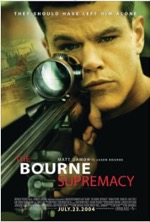
Starring: Matt Damon
July 2004
“Sequel is Supremely Disappointing”
Matt Damon is back as Jason Bourne in The Bourne Supremacy, the second film based on Robert Ludlum's popular spy novels. On the face of it, The Bourne Supremacy has just as much drama, intrigue and action as the first, but upon further reflection, the sequel falls short on several counts.
First of all, we were introduced to Bourne in the original film, so we pretty much know who he is and what he's capable of—we also know a good amount of his back-story. That's a down shot, because most of the fun in the first film was learning about Bourne as he learned about himself (amnesia).
Another aspect missing from the sequel is the romance factor. Bourne's girlfriend, Marie (Franka Potente), is seen in the first ten minutes and then she's conveniently killed off. I say convenient, because Marie's death does service the plot; Bourne comes out of hiding—with a vengeance—and starts tracking down the Russian assassin (Karl Urban) responsible for killing Marie and framing him.
The cast in this movie is almost identical to the previous one with a couple of notable exceptions. Deceased Agent Conklin (Chris Cooper) shows up in one of Bourne's retrieved memories—his first assignment when he killed the Russian president. Brian Cox (X-Men 2) is back as Ward Abbott, the hard-nosed, no-nonsense agent who stops at nothing to cover up top secret project Treadstone, including murdering a fellow agent, and, ultimately, committing suicide. Julia Stiles pops up again in the C.I.A. field ops and is reduced to set dressing once again, performing in a handful of scenes and delivering an equal number of lines. Her character serves no purpose, whatsoever, and Stiles makes such a superfluous cameo, that I don't even remember her character's name. The new face belongs to Joan Allen, who plays the tough, yet sympathetic Agent Pamela Lundy, the most fleshed-out character in the film other than Bourne.
There's a new director this time around, Paul Greengrass, and though his style lends itself to action pictures, his big car chase at the end of the movie was too long and frenetic—the scene plays like a six minute blur. And why another car chase, I ask? We already had our requisite pursuit last movie. Also, we’ve already seen a mano a mano slugfest between Bourne and some well-trained assailant the last time. The subway sequence was original, but most of the action in The Bourne Supremacy feels like stock footage from The Bourne Identity. The Bourne Supremacy is a slightly better than average action movie that doesn't measure up to the first and falls woefully short of my supreme expectations.
Rating: 2 1/2
I, Robot (PG-13)
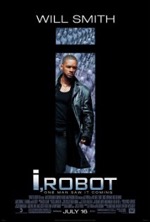
Starring: Will Smith
July 2004
“Near-future Thriller With More Than Artificial Intelligence”
I have to admit, I, Robot was a lot better than I thought it was going to be. The script was “suggested” by Isaac Asimov’s classic book of the same title, but bears little resemblance to the original, save for the three laws of robotics and how a conflict in logic makes robots go haywire.
The movie opens with the suicide—later determined to be a homicide—of Dr. Alfred Lanning (James Cromwell), and detective Del Spooner (Will Smith) is called in to investigate. Spooner, who detests robots, soon picks up the trail of the fugitive robot and, after an extensive chase scene, brings the artificial man to justice. What Spooner uncovers in his investigation, however, is just the tip of the proverbial iceberg and a much bigger, sinister plot threatens to unleash itself upon the futuristic version of Chicago, circa 2035. Dr. Susan Calvin (Bridget Moynahan) is the only one who believes Spooner’s paranoid theory (no robot has ever killed a human before) and, along with the assistance of good robot, Sonny, helps Spooner fight off hoards of renegade robots while attempting to destroy the faulty computer brain that has turned the new NS-5s into aggressive, killing machines.
Smith doesn’t swagger as much in I, Robot as in Independence Day or the Men in Black films. There’s a bit more depth to his character this time around and Smith brings a maturity of craft to bear upon the part as the android-loathing detective—a role both emotionally and physically demanding.
The special effects in I, Robot are top notch and the near-future technology is especially ingenious: like holographic caution tape, futuristic freeways and cars (some with perfectly circular tires) and, of course, the eerily human-looking robots. Though visually tantalizing, I, Robot is derivative of other sci-fi extravaganzas: the armies of robots harkens back to the armies of battle droids in Star Wars: Episode I, or the throngs of clone troops in Star Wars: Episode II. Also, V.I.K.I, the main computer in control of all NS-5s, invokes marshal law and starts taking over the city by force—“humans must be governed for their own good,” the cold, logical, positronic mind reasons. This is the prelude to a scenario not unlike the Skynet tragedy as featured in the Terminator trilogy.
Even though it’s less than original, I, Robot is a great action flick that keeps you on the edge of your seat with an unexpectedly good storyline and I-popping I-candy to go with your popcorn.
Rating: 2 1/2
King Arthur (PG-13)
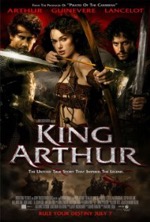
Starring: Clive Owen
July 2004
“Disney Revises History…Again”
The opening of the movie posits the notion that King Arthur was alive during the twilight of the Roman Empire and that he was half-Roman and half-Briton. This historical twist is based on newly discovered documents (okay!) that reveal Arthur was alive earlier than generally supposed, as much as a thousand years before the medieval period. Who knew?
The story follows Arthur and his band of scrappy warriors as they fight for their lives and their freedom from Rome; they have one final assignment and then they will receive their papers, but the simple mission goes south when an army of nasty Saxons shows up. A portion of the army chases Arthur, his men and some villagers across an icy lake, and as fate and Hollywood would have it, the ice breaks and swallows most of the Saxons and none of Arthur’s men...or the scantily-clad Guinevere (Keira Knightley), who seems unaffected by the arctic conditions (more on her later).
There's a final standoff between the main Saxon army and Arthur, who rides onto the battlefield alone (he has a host of primitive Ewoks, I mean, Woads waiting in the forest under the command of non-magical Merlin). The climactic battle goes through the motions and tries to wow the audience with gee whiz effects, but the action is static and turns King Arthur into just another excuse to update a classic tale with modern special effects, just because we can.
Even despite the historical paradigm shift, there are way too many anachronisms in King Arthur that detract from the overall purpose of the movie and distract the audience with unnecessary silliness. Take potty-mouthed Sir Bors (Ray Winstone), for instance. Although he provides some much-needed levity, his speech and mannerisms don't match a man of that time period, especially one of Arthur's handpicked champions. Or how about the witch-doctor version of Merlin, who leads a band of hairy, wild Woads (Caucasian aborigines) into battle beside Arthur? And what about Guinevere? In this version of the Arthurian legend, she's less like the traditional princess and more like an Amazon woman, adorned with one, narrow strip of leather across her chest. Are we sure these newly discovered historical documents aren't really Xena re-runs?
Other than Knightley, the only other familiar name in the cast is Clive Owen (Beyond Borders). Owen's Arthur is a courageous man of faith, but sometimes his delivery is too stuffy and dispassionate. All in all, King Arthur will be an epic disappointment to anyone who isn't a Knightley fan.
Rating: 2
Spider-Man 2 (PG-13)
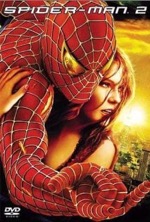
Starring: Tobey Maguire
June 2004
“Comic Book Art Meets High Art”
Spider-Man 2 scales far higher than its predecessor and will undoubtedly surpass the box office mark set by the original. With two solid chapters firmly lodged in the multi-million dollar web, this is already the most overwhelmingly well-received comic-to-screen adaptation and certainly, with just two movies, one of the top-grossing series to date. I’ll go one step further: not only is Spider-Man 2 one of the best sequels of all time, it’s without a doubt the finest superhero movie ever made (move over X-Men).
Tobey McGuire is back as the angst-ridden Peter Parker, and Kirsten Dunst has returned as the object of Peter’s undying affection, Mary Jane Watson (M.J.). A couple years have passed since the first film and Peter is living in a rundown apartment and struggling to pay the rent since he keeps getting fired from entry-level jobs. M.J. has made a name for herself in theater and her face adorns posters and billboards all over the city—ubiquitous and painful reminders for Peter, whose unrequited feelings for M.J. consume his every waking thought.
Peter’s life has begun to unravel due to the demands of being Spider-Man. In addition to his inability to hold down a job, he’s failing college and owes his professor a paper on fusion. Peter prevails upon his good friend Harry Osborn (James Franco) to introduce him to his hero, a fusion expert named Dr. Otto Octavius (Alfred Molina). During an ill-fated fusion experiment, Octavius is transformed into Dr. Octopus, an eight-limbed (four mechanical appendages) menace bereft of conscience or compunction.
Doc Ock goes on a rampage—robs a bank, tosses security guards around like rag-dolls, uses Aunt Mae as a hostage and later takes M.J. hostage. Doc Ock plans to rebuilt the fusion generator, and it’s up to Spider-Man to stop the tentacled madman; however, several complications arise, not the least of which involve his best friend’s hatred of Spider-Man, his own inability to produce webs when distracted by M.J.’s recent engagement to the “Daily Bugle” editor’s son and the rejection he experiences when he confesses to abetting in the death of Uncle Ben (not the rice, silly).
There’s a lot of character development in Spider-Man 2—more so than the first, in fact—and the action sequences, though cutting-edge and pulse pounding, are few. Though atypical for an action film, Spider-Man 2 is an excellent model—and hopefully, trendsetter—for future comic book-based movies. Spider-Man 2 is really the only current action picture I can think of that hasn’t sacrificed character development and plot for glitzy special effects—it’s a complete movie, exhibiting the perfect blend of action, comedy and drama. Spider-Man 2 is movie magic because it has heart, something sorely missing from most big-budget extravaganzas these days.
Tobey McGuire, bad back and all, does a fantastic job of expanding our knowledge of Parker’s inner struggles—he makes the character believable and vulnerable—while maintaining the wit and whimsy that made the character viable and likeable in the original. Alfred Molina has realized one of the most three-dimensional villains in recent cinema history. Though his portrayal of Spidey’s chief nemesis is a bit over the top in spots, the humanity and pathos he infuses the character with elevates Doc Ock above the morass of garden-variety villains. Near the film’s climax, there’s a scene of redemption where Dr. Octavius, now in control of his four pesky appendages, destroys the experiment and drowns himself in the process.
Spider-Man 2 features fine performances by Dunst, Franco and J.K. Simmons as the impulsive, joke-a-minute editor of the “Daily Bugle,” J. Jonah Jameson, but Rosemary Harris really steals the show in her supporting role as Peter’s Aunt Mae. Here’s an actress with an amazing craft—her “heroes” speech to Peter is one of the most poignant moments of the film.
The lion share of the movie’s success belongs to Academy-award winning screenwriter, Alvin Sargent and director Sam Raimi. Like in the first film, Raimi expertly balances action and character scenes. His tip of the hat to the seventies, with “Raindrops Keep Falling on My Head” and his freeze-framed shot of Tobey McGuire, is absolutely hilarious. Spider-Man 2 is high-powered, high concept fare that will appeal to those ages seven to one hundred and seven—it’s brought the fun back to the Cineplex.
Rating: 3 1/2
The Terminal (PG-13)
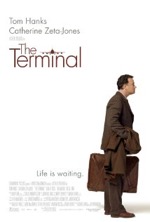
Starring: Tom Hanks
June 2004
“Soars, Despite Being Grounded”
Tom Hanks and Steven Speilberg have become an unstoppable duo at the box office, and every time they collaborate on a film, their mastery of craft and vision increases exponentially (and let's not leave multiple Academy award-winning composer, John Williams, out of the equation; Williams turned in a wonderful, Baltic-flavored score for The Terminal).
Though the premise of the film is quite simple—Krakozhian citizen, Viktor Novorski, is trapped in J.F.K. because his country is at war and the U.S. won't recognize his passport—but it's Viktor's spirit of determination and decency, and the friendships he makes at the terminal, that really gives the movie wings. Viktor is a survivor, he creates a makeshift bedroom in an old, unused airline gate, learns how to speak passable English, learns how to make a living so that he can eat and helps out a lot of people along the way, who, in turn, help him.
One of these friends is Enrique (Diego Luna), a love struck errand boy who agrees to feed Viktor in exchange for information about the beautiful, vibrant immigration agent Viktor sees every day. Viktor is a go-between and, after some time, delivers a ring to the young woman with instructions to join the man of her dreams at the Sbarro pizza joint in the terminal. She meets her secret admirer and the couple is soon married—in the terminal, of course.
Admittedly, this is a little far-fetched—and if there’s an Achilles Heel to this wonderfully endearing tale it's that, despite the veneer of fully realized characters and events, the entire script is fictitious. Everything in the film is well crafted and well acted, but the underlying lack of authenticity makes the story, as a whole, hard to buy.
Take the failed romance between Viktor and "cheating" stewardess, Amelia (Catherine Zeta-Jones), for instance. The writers employ the old apple on a string routine by building up a potential relationship between Viktor and Amelia, but in the end, they yank back the string, and all you're left with is a mediocre, under-developed subplot to close out the movie. Granted, the end of the movie is uplifting—Viktor finally gets out of the airport, and the twit-in-a-suit, head of airport security (Stanley Tucci) fails in his attempt to contain Viktor—but Viktor’s victory in securing the final autograph of a jazz musician for his deceased father is hardly the expected or desired payoff for the film.
Despite its slow pace and utter lack of action, The Terminal is a feel-good drama recommended for anyone who doesn't get claustrophobic.
Rating: 3
The Day After Tomorrow (PG-13)
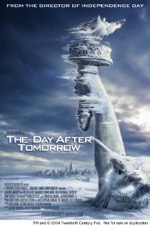
Starring: Dennis Quaid
May 2004
“Farcical, But a Fun Ride”
The eighties gave us The Day After, a story about the bitter reality of a nuclear holocaust. Now, the new millennium has delivered us a fresh breed of disaster film in The Day After Tomorrow, which brims with a variety of natural calamities and an amazing array of effects to bring them to life.
Granted, the movie is much more enjoyable when you suspend your disbelief right from the opening credits. As unbelievable as it is to accept that global warming can cause an ice age, it's even more of a scientific fallacy to think that an ice age will expend itself after just one week. But that's exactly what happens in Roland Emmerich's (Stargate and Independence Day) big budget, big name flick that stars Dennis Quaid and Jake Gyllenhaal.
Here's the Reader's Digest version: Jack Hall (Quaid) is a renowned paleoclimatologist (say that ten times fast and I'll buy you a sno-cone) who predicts a coming catastrophe due to radical climate shifts. Jack's son, Sam (Gyllenhaal), is on his way to New York City to compete in a high school academic competition. Of course, that's when the earth goes into an epileptic fit, releasing tornadoes in Los Angeles, forming massive tidal waves in Manhattan and unleashing uber-blizzards at the poles.
The rest of the movie is about survival and the human condition in severe conditions. Jack and his two partners strike out to rescue Sam and his classmates, who have retreated into the warmest room of the New York Public Library and have been burning books to stay warm. Jack's vehicle breaks down just outside of Philly, and he walks the rest of the way to Manhattan over snow and ice in just a couple days (is your disbelief still suspended?). In the end, Jack rescues his son, but the resolution is bittersweet because the northern U.S. is now an icebox.
Other than special effects, I don't see The Day After Tomorrow winning any major awards, and there are several reasons why. Even with shallow character development (Sela Ward and Ian Holm were tremendously underserved), a derivative plotline and shoddy science, the biggest injustice in the film is its blatant political agenda. However extreme and speculative, the environmentalists have made their point about the side effects of mass energy usage.
The movie became a platform and to its own detriment—The Day After Tomorrow would have been much more enjoyable without the sermon on conservationism. And what about the other message during the reverse-immigration scene, when thousands of Americans flood into Mexico, seeking warmer environs and the ensuing politically correct speech delivered by the newly-promoted president of the U.S.? Again, The Day After Tomorrow was a great popcorn movie, but these "preachy" moments made me choke on a kernel. Oh, and one more thing, what business does a wild pack of wolves have roaming into a disaster picture?
Rating: 3
Shrek 2 (PG)
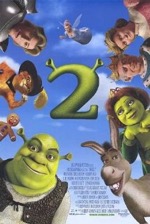
Starring: Mike Myers
May 2004
“Not as Original as the Original”
Shrek 2 picks up where the first movie left off, more or less. The video portion of the 3-D ride at Universal Studios (which has now been released on DVD, complete with 3-D glasses) serves as an unofficial Shrek 1.5.
All the regulars are back from the original movie; Mike Myers as the abrasive ogre, Shrek, Eddie Murphy as the vociferous Donkey and Cameron Diaz as the model turned ogrette, Princess Fiona. Some new faces—and accompanying voice talents—also grace the jolly green sequel, like Antonio Banderas as Puss In Boots, Jennifer Saunders as the Fairy Godmother, Rupert Everett as Prince Charming, comedian John Cleese as Fiona’s father and the incomparable Julie Andrews as Fiona’s mother.
The movie opens with the long, exhausting journey to the land Far, Far Away, which turns out to be a fairy tale version of Hollywood (wait a minute, Hollywood is a fairy tale!). The king and queen, along with the rest of the kingdom, go into collective shock when the ogre couple jumps out of the onion carriage. One of the highlights of the movie is the ensuing dinner at the royal table, where insults and belches abound in one of the most unique “meet the parents” sequences ever committed to film. Later that night, the king plots to have Shrek assassinated by Puss In Boots. His evil scheme expands when he arranges a wedding between the reverted Fiona (a potion belonging to the Fairy Godmother changes her back to a beautiful princess) and Prince Charming. Of course, the King’s plans are foiled and they all live happily ever after, but some hilarious misadventures take place before the storybook closes.
The double entendres have been toned down from the first picture, but inside gags and tips of the hat to other movies or TV shows are ubiquitous…in fact, you can make a game out of who can find the most references. Here are just a few: as they ride into Far, Far, Away, you can see a sign that reads “Farbucks Coffee.” Rolling up the hill, Donkey says, “Swimming pools and movie stars” (Beverly Hillbillies). Later still, Puss In Boots pops out of a guard’s breastplate (Alien).
But even with new characters, situations and gags, Shrek 2 still doesn’t live up to the quality of its predecessor. There’s something missing from the movie, but it isn’t easy to determine what that absent something is. Maybe it’s that the newness has worn off or that Shrek 2 doesn’t have the same “movie magic” that the original had in spades. Either way, Shrek 2 is a winner, as sequels go, but is still inferior to the original. Oh, and one more thing, make sure you sit through the end credits…there are some additional scenes that are hilarious, but just plain wrong.
Rating: 2 1/2
Van Helsing (PG-13)
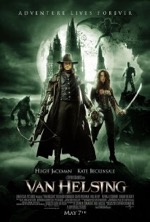
Starring: Hugh Jackman
May 2004
“Everything but the Mummy”
Mutants, werewolves and vampires…oh my! Van Helsing, the newest in a long line of creature features, is overstuffed with evil figures from classic literature. After the old-style, black-and-white prologue—which sets up Dracula’s plot and Frankenstein’s plight—Van Helsing (Hugh Jackman) dukes it out with Mr. Hyde in the chapel of Notre Dame (I thought the hunchback hung out there, not Dr. Jekyll’s alter ego). This action-packed vignette has no bearing on the storyline other than to introduce the audience to Van Helsing’s abilities and gadgets.
The story really begins in Transylvania, where villagers are being assailed by three screeching, swooping she-vampires (Dracula’s brides). Van Helsing arrives not a moment too soon and rescues damsel in distress, Anna Valerious (Kate Beckinsale), along with the rest of the harried village by shooting a crossbow dart dipped in holy water through the chest of one of the screaming demonettes.
Count Dracula (Richard Roxburgh) schemes to take over the world by mating with his wives and producing little, flying gremlins. The experiment fails and the count realizes the only way to successfully produce offspring is to find Frankenstein and discover what techniques were used to bring him to life (is this a B movie plot, or what!). Van Helsing is faced with a difficult choice: in order to save the world, he must kill Frankenstein. As he searches for an alternative, he encounters the dreaded count—the movie wouldn’t be complete without a melee between Van Helsing and Dracula.
Hugh Jackman (X-Men) is no stranger to big-budget, effects-driven pictures, and his performance gives Van Helsing some much-needed weight. Kate Beckinsale (Pearl Harbor) plays the typical tough woman, but she breaks down when her brother is turned into a werewolf. Her performance displays a convincing blend of strength and vulnerability. Van Helsing’s assistant, Friar Carl (David Wenham of Lord of the Rings fame), is the movie’s only comic relief, and is the man responsible for creating all of the weapons and devices Van Helsing employs in battle.
Helming Van Helsing is Stephen Sommers (The Mummy), who was the perfect choice considering his extensive experience with creature movies in the past. Drawing from The Mummy films and other movies like Raiders of the Lost Ark, Sommers has painted a new look for action pictures, albeit in broad, gray strokes on a rather dark canvas. Though populated with familiar characters, Van Helsing features new twists and is an exhilarating ride, despite intensely evil scenes. But, in the end, good triumphs over evil and Van Helsing rides off into the sunset toward countless sequels and marketing tie-ins, no doubt.
Rating: 2 1/2
Godsend (PG-13)
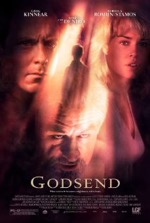
Starring: Robert De Niro
April 2004
“Disturbing for the Sake of Being Disturbing”
This is a hard movie to rate. On the one hand, Godsend is an excellent movie when it comes to acting, directing and screenwriting. However, it’s so dark and disturbing, and devoid of any kind of virtue or edification, that the natural tendency is to grade down. This isn’t the first time a movie of this genre has been produced, and there certainly have been finer examples, (i.e. The Sixth Sense and What Lies Beneath), but the fresh angle here is the salient topic of cloning and genetic manipulation.
If there’s any saving grace to Godsend, it’s that it paints a graphic picture of the potential terrors that await us as scientists continue flirting with genetics. Whereas Jurassic Park was frightening because it revealed the dangers of cloning dinosaurs, Godsend is even more terrifying because it deals with re-creating a human being.
Here’s the scenario: Paul and Jessie Duncan (Greg Kinnear and Rebecca Romijn-Stamos) loose their eight-year-old son, Adam (Cameron Bright), in a car accident. At Adam’s funeral, Dr. Richard Wells (Robert DeNiro), approaches the Duncan family and offers them a chance to get Adam back through a cell cloning process he has recently perfected. Reticent at first, the Duncan’s break down and ultimately agree to go through with the process. Eight years later, after the second Adam (the symbolism is as subtle as a 2X4 to the head) grows past the experiences of his predecessor, new memories and behaviors begin to emerge. It’s later discovered that the new personality comes from Dr. Wells’ deceased son—Wells introduced some of his son’s D.N.A. into Adam’s—who just happened to be homicidal and suicidal (he burned a school to the ground around him along with other students and teachers). The ending doesn’t really resolve anything and leaves everything wide open to individual interpretation, making it the weakest link in an otherwise thought-provoking script.
The first half of the movie is a bit slow, but does a good job of painting the main characters, their dilemma and their fateful choice. But, the second half of the film is little more than a horror movie in the vein of Bad Seed or The Good Son. Godsend services the audience by presenting a human cloning experiment gone horribly wrong, but it does a disservice by remaining morally ambiguous—presenting a case where cloning was bad “in this instance” because of D.N.A. tampering. It’s one thing to clone an animal and quite another to clone a human, or to put it a different way, we can clone a body, but can we clone a soul? This is the kind of moral/religious question the movie conveniently avoids, and maybe the safer route is the better one—after all, it’s just a movie.
Godsend is anything but, and manufactures goose bumps with haunting dream sequences, musical flourishes and things that jump at the camera. It’s a wild ride, but certainly isn’t for the faint of heart.
Rating: 2 1/2
Bobby Jones: Stroke of Genius (PG)
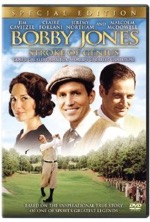
Starring: Jim Caviezel
April 2004
“Inspiring, True Story is a Hole in One ”
Football has Remember the Titans and Rudy. Basketball has Hoosiers and Space Jam. Hockey has Miracle and The Mighty Ducks. Baseball has The Rookie, The Natural, The Sandlot, Bull Durham, Field of Dreams, A League of Their Own and too many others to mention here. Now golf has Bobby Jones: Stroke of Genius, the definitive film on the subject.
Bobby Jones was arguably the greatest golfer to ever play the sport—he’s the only person in history to win all four major golf tournaments (the Grand Slam) in the same year. He was sickly as a child, but fell in love with golf at an early age, watching many golf legends play at nearby St. Andrews Golf Course in Scotland. By age fourteen, Bobby was a golf prodigy, but he retired at twenty-eight due to continued failing health and his desire to start a family.
James Caviezel (The Passion of the Christ) plays Bobby Jones, and his pitch-perfect performance reveals Jones’ many passions…both good and bad. Jones’ biggest detriments on the fairway were his explosive temper and potty mouth, both of which became manifest every time the ball went somewhere he didn’t want it to go. As a means of dealing with his debilitating condition, Jones also consumed great amounts of alcohol, which, of course, produced many additional problems. On the flip side, Jones was a decent and fair man, sometimes to a fault…at one tournament, he called a penalty on himself.
The supporting cast in the movie is exceptionally strong. Claire Forlani (Meet Joe Black) plays Jones’ supportive wife, Aidan Quinn (Practical Magic) portrays one of Jones’ golf heroes, and Malcolm McDowell (A Clockwork Orange) is Jones’ mentor (think Obi Wan with a golf club). Also appearing in a cameo role is well-known evangelist, Alistair Begg, who plays Stanley, friend of the family and a great golfer in his own right.
Stroke of Genius is a straightforward drama film that has little action, and, therefore, will seem boring to some moviegoers. The plot contains no major twists but does posit a tidbit of social commentary; Jones’ mentor makes the assertion that money is ruining amateur sports. In recent years, we’ve seen just how prophetic that statement was. Bobby Jones: Stroke of Genius is entertaining and heartwarming, but it certainly won’t go down as the greatest sports movie ever made.
Rating: 3
The Whole Ten Yards (PG-13)
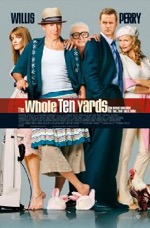
Starring: Bruce Willis
April 2004
“A Dud by Any Measurement”
I have two confessions to make regarding The Whole Ten Yards. I never saw the original The Whole Nine Yards, although I got the gist of the plot from the trailer. Secondly, I was bored with the movie even while the opening credits were still rolling. The movie failed to engage me on any level, and to call it entertainment would be a gross overstatement.
Part of the movie’s problem is its identity crisis—is it a comedy (it’s not all that funny), is it an action flick (there are only a few, short action sequences), or is it a family film (certainly not—discussions of shooting someone in the head or killing bums for sport are all too common). Since The Whole Ten Yards can’t be categorized by genre, it comes off as a particularly strange slice of Americana, complete with a highly-paranoid, tightly-wound dentist (Matthew Perry), a reformed hit man, Jimmy the Tulip (Bruce Willis), who now spends his time refining his culinary skills and tending to chickens, and his girlfriend (Amanda Peet), who desperately seeks to become the caliber of assassin Jimmy was in the past.
Add to that eccentric line-up Jimmy’s conniving ex-wife (Natasha Henstridge) and a larger-than-life mob boss (Kevin Pollack) who is revealed as Jimmy’s father in the movie’s climax (as if anyone didn’t see that coming), and you have a pretty bizarre cast of characters. The vast majority of acting in the movie is over-the-top, tongue-in-cheek and zany for the sake of being zany.
In fact, “zany” is really the most appropriate word to describe The Whole Ten Yards. It’s almost as if the producer/director/writer decided to push the envelope to absurd limits just because they could. The only scene I found remotely amusing was actually a recycled gag from Weekend at Bernie’s, where lifeless limbs of the Hungarian boss’ son are manipulated to give him the appearance of being alive. But even that was a shallow laugh.
It’s hard to find any redeeming qualities in the movie and its inane and mind-numbing storyline affixes a big minus sign to this B movie. The Whole Ten Yards may be one yard greater than the original, but it’s still a mile short of being entertaining.
Rating: 1 1/2
The Alamo (PG-13)
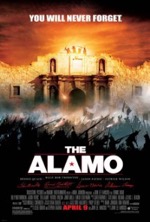
Starring: Dennis Quaid
April 2004
“Memorable Remake of Historic Tale”
Billy Bob Thornton as Davy Crockett? Dennis Quaid as Sam Houston?? No major female actor anywhere in the cast??? On the face of it, this modern take on the centuries-old massacre seems a bit underpowered and a tad ill timed. Amid the deluge of epic pictures this last fall (The Last Samurai, and The Lord of the Rings: The Return of the King), The Alamo was pushed back to this spring. Unfortunately for The Alamo, fervor for epics has sublimated a great deal since December, but will undoubtedly be rekindled with the upcoming Troy and King Arthur. It’s too bad that The Alamo was released during the lull period, because it is a solid effort.
There’s very little departure from the actual, historical events, which is a blessing and a curse. The blessing is that The Alamo isn’t “cutesy” and doesn’t succumb to radically re-writing history like so many other modern “period” pieces. The curse is that the movie feels like a glorified History Channel special; a sterile, stagnant time capsule, not a living, breathing entity. The movie stays on the fringes of the action and never really accesses the visceral emotions of the tragedy. What made blockbusters like Titanic and Pearl Harbor successful is that they introduced original characters into the action and we, as the audience, experienced the historical event through the eyes of these fictitious characters. This made us feel as if we were right there with them, becoming a part of history in a very exciting and frightening way. This storytelling style has a bigger emotional payoff if it’s executed properly, but also runs the risk of being rejected by the public and lambasted by critics.
For better or worse, The Alamo remained faithful to the original cast of characters, without introducing any new ones. The advantage to this approach is name recognition: we’re all familiar with names like Davy Crockett, James Bowie (Jason Patrick) and Gen. Santa Anna (Emilio Echevarria). The disadvantage is that there’s very little character development that can be presented outside of what we’ve already learned in history books. In the movie we see Bowie proudly display his patented knife and hear Crockett play a fiddle, and that’s nearly the extent of all character development in the picture. The only real character growth involves a lesser-known character, Lt. Col. William Travis (Patrick Wilson), who comes of age after being christened the new fort commander.
All in all, The Alamo is entertaining and is a great reminder of the sacrifices that were made so that we can enjoy freedom today…especially in the Lone Star state. However, it remains to be seen if audiences and critics will remember The Alamo.
Rating: 3
Hellboy (PG-13)
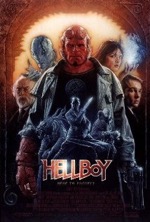
Starring: Ron Perlman
April 2004
“Hell-bent on Action”
This movie is successful for one reason: Ron Perlman. The story is engaging, but sometimes it gets either too strange of too dark. The special effects are great, but a bit repetitive—how many slobbering, butt-ugly hell hounds can you endure before you’re ready to see something else? Every other aspect of the film is well made, but it’s really Perlman’s performance that prevents Hellboy from sliding into the Valhalla of B movies. Perlman has spent most of his career covered with make-up and prosthetics—Beauty and the Beast (TV show), Blade II and Star Trek: Nemesis just to name a few—so he was a natural choice for this devil-may-care hero, who has now been vaulted from the pages of the Dark Horse comic book onto the silver screen.
Hellboy has leathery, red skin, a massive right forearm (Cheesy Line Alert: “Look at that Whammer!”), and two filed horns on his forehead—in short, his appearance is anything but human. And yet, Perlman has infused the character with so much wit and vulnerability, that Hellboy exhibits more humanity than any other person—human or other—in the movie.
Hellboy has a close relationship with Prof. Trevor “Broom” Bruttenholm (John Hurt), the man who found the nascent red creature and became his mentor and surrogate father. Hellboy also has a secret love affair with fellow mutant, Liz Sherman (Selma Blair), a woman who can turn her assailants into toast if sufficiently provoked. The middle of the film brings about a couple of major twists with these relationships: Hellboy’s new assistant, F.B.I. agent John Meyers (Rupert Evans), unwittingly attracts Liz’s affections and Prof. Broom is killed by the movie’s antagonist, Kroenen, a centuries-old man who brandishes two retractable blades inside his cuffs and has sand for blood.
Rounding out the bizarre cast is Abe Sapien (performed by Doug Jones and voiced by David Hyde Pierce), an aquatic humanoid with incisive forensic skills and a scientist at the Bureau of Paranormal Research and Defense, Dr. Tom Manning, played by the ever-witty Jeffrey Tambor. Director, Guillermo Del Toro, helmed the action sequences with adequate panache and handled the intimate, character scenes well, but the overall darkness (both literal and spiritual) of the picture is a drawback, despite Perlman’s moments of levity. On the spectrum of comic book movies, Hellboy clobbers Daredevil and The Hulk, but doesn’t pack the punch of blockbusters like X-Men and Spiderman.
Rating: 2 1/2
Starsky & Hutch (PG-13)
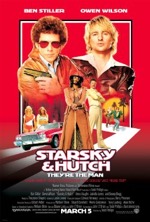
Starring: Ben Stiller
March 2004
“Groovy, But Not Great”
Acting:
This movie is Ben Stiller and Owen Wilson. Without the chemistry between these two comedic actors—who have collaborated on seven films now—Starsky and Hutch would be a fro-sized disappointment. Vince Vaughn (Psycho) does a serviceable job as the movie’s cookie-cutter seventies villain (who comes complete with a Fu Manchu mustache), and his pet, played by Juliette Lewis, is the stereotypical airhead (pothead?), flower chick whose no brains and no initiative character serves no other purpose than to massage her honey’s shoulders and deliver inane dialogue. The most colorful character in the movie is the glitzy Huggy Bear, played by Snoop Dogg, a shady figure who walks a dangerous tightrope between both sides of the law. His scenes as the golf caddie are absolutely hilarious. Carmen Electra adds a pretty face to the movie, but little more.
Director:
Starsky and Hutch—the movie—is nothing more than a glorified seventies television show, which seems to be the intent of director Todd Phillips (Road Trip). Besides hair and clothing styles and accompanying faves from groups like The Carpenters, Phillips utilizes old-style camera moves to capture the flavor of the original show. And, if you’re going to have a movie based on a seventies TV show, you’d better have the requisite fistfight and prolonged car chase, which, of course, this modern version also features.
Screenplay/Story:
Like the rest of the movie, the plot is typical of the seventies TV show, but the story elements, such as drugs, free love and violence have been updated, modernized and pushed to the extreme. In comparison to this new flick, the original TV show seems sanitary: what was a cutting-edge cop drama in the seventies would now be considered a family show. Social commentary aside, the movie never goes anywhere; there are no curveballs, no cliffhangers and no creative flourishes in most respects. Complete with the iconic, cherry-red Gran Torino with white lightning bolt along the side and a sea of Afros and bell-bottoms, the story is nothing more than nostalgic drivel.
Final Analysis:
Matinee all the way, dude!
Rating: 2
Hidalgo (PG-13)
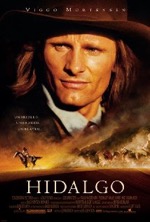
Starring: Viggo Mortensen
March 2004
“Intelligent and Inspiring Action Movie”
The trailer for Hidalgo proudly boasted: “The king is back.” The king, of course, refers to Viggo Mortensen’s Aragorn from Best Picture winner, The Lord of the Rings: The Return of the King. This assertion is no understatement. Mortensen, a journeyman actor with dozens of supporting roles to his credit, has finally come into his own as a leading man. Besides his striking features—which make most women wilt—Mortensen is adept at playing dramatic, comedic or action sequences, and can transition from one to the next faster than you can say Frodo.
Mortensen’s portrayal of real-life horse racer, Frank T. Hopkins, is a unique blend of Aragorn and Indiana Jones—Hopkins’ adventures along the 3,000 mile “Ocean of Fire” race in the Arabian Desert were equal parts exhausting and inspiring. A special relationship existed between Hidalgo, the painted mustang, and Hopkins, and this rapport serves as the spine of the tale; everything else in the movie is just historical (dubious in some instances) window-dressing. Hidalgo was mixed, as was his master—Hopkins was a half-breed, a Native American whose Caucasian features saved him from the slaughter at Wounded Knee. Enduring great internal and external adversity, these two wounded spirits drew strength from each other, overcame impossible odds and emerged as the victors of the endurance race.
Some silver screen legends appear in the film: Malcolm McDowell’s (A Clockwork Orange) character only appears for a brief instant on the trans-Atlantic cruise ship, but Omar Sharif (Dr. Zhivago) plays a more significant role as the Muslim leader in charge of the race. Director, Joe Johnston (Jumanji, October Sky and Jurassic Park III), was the perfect choice for Hidalgo, a movie with adrenalin-filled action sequences and intimate character vignettes—Johnston excels in both areas.
Hidalgo has a certain charm about it that is akin to the old-style Westerns, where the good guy always prevailed thanks to his own virtue and the loyalty of his steed. It’s this kind of old-fashioned storytelling that is sadly lacking from most Hollywood movies today. Some will find Hidalgo wanting as an action picture because of its attention to character development and plot, but these are the very elements that lift the movie above the morass of shallow, effects-laden films that seem to dominate at the box office. Hidalgo is and intelligent and inspiring adventure movie that’s appropriate for the entire family.
Rating: 3
The Passion of the Christ (R)
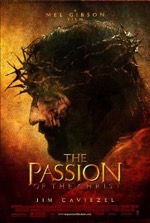
Starring: Jim Caviezel
February 2004
“The Most Graphic Story Ever Told”
The Passion of the Christ is the most powerful and controversial movie ever made. What makes the film powerful is an engaging script, emotional performances and inspired direction; it’s the first “Jesus” movie that’s ever depicted the Savior with more than just a trickle of blood flowing down His brow. It’s controversial because of the graphic scenes surrounding Christ’s torture and crucifixion and due to charges of anti-Semitism.
POWERFUL:
Beyond the scourging and crucifixion, The Passion of the Christ is powerful because of the humanness of the characters and the horrific situations they find themselves in. Take Pilate (Hristo Naumov Shopov), for example; reticence is written all over his face as he presents Jesus to the seething mob. Whether filled with compassion or dispassion, it’s very clear that Pilate feels trapped and just wants to rid himself, one way or the other, of “the king of the Jews.” And then there’s Mary, mother of Jesus (Maia Morgenstern). As Jesus stumbles down the Via Dolorosa, toting the cross on His back, He falls to the ground and Mary has a flashback to when Jesus tripped and scraped His knee as a boy. Who will ever forget the look on her face? Or who will ever be able to forget Jesus’ anguish in the garden or the scourging or the crucifixion as a result of James Caviezel’s Oscar-caliber performance? Or the downright creepy portrayal of Satan by Rosalinda Celentano?
CONTROVERSIAL:
Is The Passion of the Christ anti-Semitic? Pilate washes his hands of Christ’s blood, so that would seem to place bloodguilt on the Jewish people. And yet, it was the Romans that nailed Him to the cross. I think the point is clear: we are all guilty. It was our sin that nailed Christ to the cross; that’s why none of the faces of the Roman guards are shown. It’s almost as if director, Mel Gibson, is saying, “insert your face here.” As has been well publicized, it was Mel’s hands that were shown hammering the nails into Christ’s hands and feet in the movie—we must all take responsibility for the weight and consequences of our sin. That’s the message of the movie, not that the Jews were solely at fault.
The film is also controversial in some Protestant circles, as Gibson textured the movie with many added or contrary elements borrowed from Catholic mystic, Anne-Catherine Emmerich. At first glance, the aberrations from the sacred text simply seem to be stylistic embellishments, but upon further scrutiny, these altered scenes would certainly smack of heresy in the Protestant mind.
Here are just a few prime deviations from scripture: 1. Satan tempts Jesus in Gethsemane, 2. Jesus is lashed thirty-nine times on the front and back, 3. Pilate’s wife gives Mary some towels, 4. Mary and Mary Magdalene wipe up Jesus’ blood after the whipping, 5. A crow pokes out the eye of the unrepentant thief and 6. Roman soldiers take Jesus off the cross (the Bible claims that Joseph of Arimathaea and Nicodemus took Him down).
Whether you view the movie as controversial or whether you even believe the story is presents, there should be no doubt in anyone’s mind that this is a stupendous achievement…a superior piece of cinema. With A-list acting, directing, writing and scoring, The Passion of the Christ is an illumined effort, divinely crafted with images and events that won’t soon be forgotten.
Rating: 4
Welcome to Mooseport (PG-13)
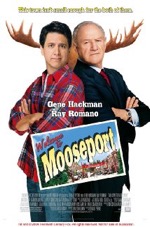
Starring: Gene Hackman
February 2004
“Welcome to Mediocre Entertainment”
Acting:
I don’t know what’s more amazing, the fact that this movie has a stellar cast or that a stellar cast would agree to do this movie. And stellar is no understatement. Movie stalwarts Gene Hackman (Runaway Jury) and Marcia Gay Harden (Mystic River) add their talents to the film, but seem out of place amid such pedestrian fare. Television hacks, Ray Romano (Everyone Loves Raymond), Maura Tierney (ER), Christine Baranski (Cybil) and Fred Savage (The Wonder Years) round out the cast, but there’s no stand out performance—here is a solid group of actors who desperately try to give weight to their roles but can’t because of the poorly written…
Screenplay/Story:
The scenario of a newly retired president of the United States running for mayor against the local plumber in a sleepy burg in Maine is just about as far-fetched as they come. Did the writers stop to answer the “Who cares?” question before they attacked their keyboards? Of course not! The only story element that gives Welcome to Mooseport any spice is the jealousy factor. Ex-president, Monroe “Eagle” Cole (Hackman) asks out Sally Mannis (Tierney) who is dating Handy Harrison (Romano). Sally is waiting for Handy to get the gumption to ask her to marry him, so she spites Handy and accepts the dinner invitation with Monroe. Now Monroe and Handy are fighting for the same office and the same woman. The date between Monroe and Sally also elicits jealousy from Monroe’s assistant (Harden), who has secretly admired the ex-pres. for years. In the end, Handy proposes to Sally and Monroe and his assistant hook up. And, with the exception of a thinly veiled election twist, that’s the extent of the plot.
Final Analysis:
Welcome to Mooseport tries to be funny, but isn’t. This is Ray Romano’s big screen debut and with a performance like this, he should stick to the small screen where he has great comedic success. The movie screams “low budget”…there are very few sets and the characters never leave the stifling confines of Mooseport. It’s too bad the story couldn’t support the caliber of actors it features and that its writers couldn’t come up with something more original and engaging.
Rating: 2
Miracle (PG)
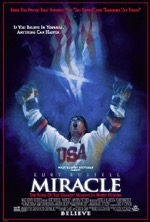
Starring: Kurt Russell
February 2004
“Real Story with Real Heart”
Acting:
This is a defining role in Kurt Russell’s career—ironic since he got his start doing cornball movies for Disney in the sixties. Russell’s portrayal of coach Herb Brooks is natural and believable, especially his Minnesotan accent. Brooks was equal parts coach, motivational speaker and psychologist and Russell melds all three seamlessly. Patricia Clarkson (Far From Heaven) plays Brooks’ wife, a woman who grapples with her distant husband’s other love—hockey. In the end she decides to stand by her man through the stormy moments of their marriage—something that happened far more frequently in 1980 than in the present day. Noah Emmerich (Frequency) is Brooks’ loyal assistant coach, an underserved character that has more whistle blows than lines in the movie.
Costumes:
Nice checkered wool pants!
Screenplay/Story:
Miracle is based upon the true story of the gold-medal winning U.S. Hockey team at the 1980 Olympic winter games in Lake Placid, N.Y. A total David and Goliath scenario: a newly assembled American team of young college players defeats a veteran Soviet Union team which had won every gold medal in their event for the last twenty years. There’s no surprise ending here—the story of this “miracle” team and its exploits have been touted as one of the greatest moments in amateur sports for the last twenty-four years. What makes Miracle worth seeing is not so much the end result as the journey that got them there. Brooks’ unorthodox coaching strategies and the personal stories of the young men on the team create the backbone of the story—without these ingredients, the movie would be little more than a glorified sports documentary. And speaking of documentary, the historical footage that peppers the new scenes really gives the movie a proper sense of context and provides a great deal of authenticity.
Final Analysis:
Miracle is an inspirational movie the whole family can enjoy and imparts a sense of pride and patriotism. The movie is a testament to the fact that miracles can still happen with focus, determination, teamwork and good old-fashioned hard work—an important reminder to a generation that has faced very little adversity…lest we forget.
Rating: 3
Big Fish (PG-13)
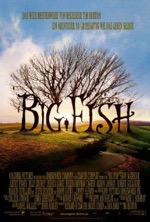
Starring: Ewan McGregor
January 2004
“Fanciful Tale that Flounders at Times”
Bizarre. It’s the only word that seems to fit this lavishly mounted, finely crafted, yet strangely avant-garde effort.
Touted as Tim Burton’s masterpiece and a modern Wizard of Oz, and seemingly falling short on both counts, Big Fish is, however, a wildly imaginative romp through the mind and memories of Edward Bloom (Ewan McGregor and Albert Finney), a man of unique vision and singular purpose.
Through a series of flashbacks—which contain elements of truth but come off like tall tales—the aged Edward regales stories of love and war, mysteries and misadventures to his estranged son, Will (Billy Crudup). Giving color to the vignettes is a diminutive circus master who becomes a wolf at night (Danny DeVito), a poet turned bank robber (Steve Buscemi), and a beautiful young blonde (Helena Bonham-Carter), who also appears as a frightening witch; if you stare into her blind eye, you will see the moment of your death.
For all of its strangeness, however, there’s an underlying humanity that shines through and anchors the more whimsical elements of the film. The movie finally finds its voice near the end when Will, normally embarrassed by his father’s flamboyant stories, comes to understand their purpose and honors Edward with an embellished version of his father’s final moments. It’s at this point that you realize the movie hasn’t been about far-fetched tales at all, but about the characters in the story. This is nowhere more vividly displayed than at Edward’s funeral; all of the fanciful figures in his stories are in attendance—though far less outlandish in real life.
Due to its excessive ambiguity and multi-faceted storyline, there are many philosophical nuggets to be unearthed here—some of which are buried quite deep. There’s a parallel between the pristine town of Spectre and the U.S. in the 50s: the supposed Golden Age of American history. When Edward returns to the little slice of paradise later in his life, he is shocked to find the burg in shambles. This might be a representation of present day (or post 9-11) America. Of course, this is one possible interpretation of the movie, and that’s what makes Big Fish so intriguing and endearing. What is the truth and what does it mean in a subjective sense?
Big Fish asks more questions than it answers, but it does entertain and features fine performances by McGregor and Finney. In the end, it remains somewhat of an oddity, but it’s certainly a better catch than the normal fish story.
Rating: 2 1/2
Peter Pan (PG)
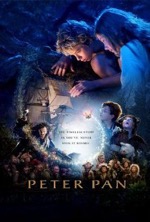
Starring: Jeremy Sumpter
December 2003
“Return to a Dry Well”
Acting:
This new, live-action spin on J.M. Barrie’s classic tale, Peter Pan boasts a solid cast of virtually unknown actors. Two performances stand out above the others; Jeremy Sumpter, who plays the title role and Jason Isaacs, whose dual role as Mr. Darling and Captain Hook is one of the few highlights of the movie. From a dramatic standpoint, this new movie features the best version of Hook ever committed to film—Isaacs’ portrayal of the sinister pirate captain is darker and subtler than any previous attempt, but the petulant Hook in Disney’s animated Peter Pan and Dustin Hoffman’s scheming and foreboding figure in Hook were both more amusing and more memorable than this year’s model.
Director:
Who the heck is P.J. Hogan?
Screenplay/Story:
The big question is, “Why do we need another remake of this story?” We have the aforementioned Disney’s Peter Pan and Hook, and the recent straight-to-video flop, “Return to Neverland,” plus a cartoon series in the early nineties and a slew of story variations on stage. Truth is, it’s been done before and it’s been done better. There are only a few story elements that don’t come off like stale toast (or crumpets). There’s a nice touch at the beginning of the movie when Mr. Darling tries to impress his boss and bumbles all over himself—quite amusing. The reunion of the Darling children with their mother at the end of the movie packs a surprisingly emotional punch and is probably the most touching dénouement of any Peter Pan.
Special Effects:
There’s a very creative scene where Peter and the Darling children are spying on the Jolly Roger from up in the clouds and the pirate ship starts firing cannon balls through the clouds—great visual. The worst effect in the film is Hook’s bane; the crocodile’s movements look extremely unbelievable and unnatural in this shoddy piece of CGI. The best, and most beautiful, effect in the movie is in the forest, where an entire community of ferries dance and flit about like fireflies against the night sky.
Final Analysis:
If we ever return to Neverland, it will be far too soon.
Rating: 2
Paycheck (PG-13)
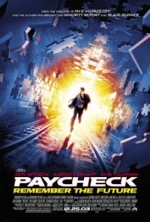
Starring: Ben Affleck
December 2003
“Futuristic Thriller With a Twist”
Part spy thriller, part sci-fi movie, “Paycheck” is one hundred percent action flick that starts out at a fevered pitch and never slows down. Based on a short story by Phillip K. Dick (Blade Runner), “Paycheck” introduces an inventive, yet disturbing, vision of the future; a “what if” scenario. What if highly trained computer experts and bio-engineers were implanted with a marker at the beginning of a top-secret project and, when the job was completed, their memories were wiped all the way back to the point of marker insertion? What if you lost three years of your life (memories), but received remuneration for your services somewhere in the ballpark of eight figures? But what if the project you worked on was illegal, and the F.B.I. shows up and you have no memory of what you’ve been doing for the last three years?
Michael Jennings (Ben Affleck) is on the run from his former employer and the feds., and all he has to aid him in his search for answers to the past is a manila envelope filled with a dozen ordinary items that he had the foresight to send himself before the memory wipe. A latent memory of a significant other leads Michael to Rachel (Uma Thurman), the one person who can help him get back into the lab and destroy the machine that he built…a device that will lead to great catastrophe in the future.
Oversimplified? Far-fetched? A bit confusing? You bet! But if “Paycheck” has any redeeming quality, it’s that it doesn’t linger in one place too long. John Woo (Mission Impossible 2) does a good job of building intensity and sprinkling in action sequences at appropriate times until the explosion-filled climax.
Ben Affleck has tried his hand at being the lead in a thriller before (The Sum of All Fears), but his low-key—almost passionless—portrayals will prevent him from becoming an action star for the foreseeable future. Uma Thurman, a fairly well respected actress in drama, comedy and action circles adds very little to the movie—her vanilla performance will be forgotten shortly after the movie vacates theaters.
Even with mediocre elements, “Paycheck” somehow, inexplicably, manages to become more than the sum of its parts. This is, undoubtedly, due in large part to the genius of the source material the movie draws upon, proving once again that a slightly above average story can bail out average performances. “Paycheck” is a good popcorn movie that works great after you’ve suspended your disbelief, and works even better when you’ve only paid the matinee price.
Rating: 2 1/2
The Lord of the Rings: The Return of the King (PG-13)
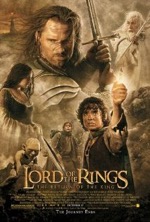
Starring: Elijah Wood
December 2003
“Triumphant Finale of Modern Masterpiece”
The word “triumph” hardly seems to suffice when used to describe the stupendous achievement that is The Return of the King, the third and final chapter in the Lord of the Rings trilogy. The battles are bigger, the stakes are higher and emotions run deeper in this installment, which was labeled a modern classic by movie critics even before the film was released. Some would call that kind of buzz a heady brand of Hollywood hype. The problem with hype is it seldom lives up to its billing or to the audiences’ expectations. Hype for The Return of the King, however; is like holding a postcard from Disneyland, whereas the movie itself is like an exhilarating day of non-stop rides inside the real park.
Picking up right where The Two Towers left off, The Return of the King forges ahead with multiple plot lines, a device that auteur Peter Jackson masterfully employed in the middle film. Sideline Hobbits Merry (Dominic Monaghan) and Pippin (Billy Boyd) are finally elevated from comic relief status and actually figure prominently in the film’s major battle. The wizard, Gandalf (Ian McKellen) is, again, underserved, but makes the most of his meager screen time; dispensing wit and wisdom with ease and demonstrating the battlefield prowess of a fierce warrior. Legolas (Orlando Bloom) and Gimli’s (John Rhys-Davies) friendship continues to deepen and is a genuine and heart-warming example of racial reconciliation. There are so many other wonderful characters (Bernard Hill’s Theoden and Miranda Otto’s Eowyn, just to name two) that give color and texture to the Tolkien/Jackson canvas, but the heart of the story involves Aragorn’s (Viggo Mortensen) claim to the throne and Frodo (Elijah Wood), Sam (Sean Astin) and Gollum’s (Andy Serkis) fateful journey to Mt. Doom; the only place in Middle-earth where the surpassingly evil “one ring” can be destroyed.
Aragorn has finally arrived in this film; he has clarity of purpose and a sense of urgency and resolve previously unseen in the trilogy. Armed with newfound gravitas, Aragorn flexes his royal muscles in two key moments: 1. He doesn’t take no for an answer when conscripting the aid of the Army of the Dead, and 2. He delivers a rousing, courageous and honor-inducing speech (the kind that would make you follow him over a cliff if he requested it) when leading his army against the hoards of orcs assembled at the foreboding Black Gate.
The technical aspects of the movie are nothing short of miraculous (The Battle of Pelennor Fields makes Helm’s Deep look like recess), but as with the other two pictures, dazzling effects don’t upstage the actors or the struggles their characters face—Jackson, again, brilliantly balances the epic and the intimate in seamless, yet impacting, ways. And this is nowhere more evident than with the bound-by-fate ménage a trios of Frodo, Sam and Gollum. Here is the real vertex—the focal point—of the entire expansive tale. The trio’s flight into the heart of disheartening Mordor brings attitudes and motives to a head: Sam’s escalating distrust of Gollum, Frodo’s increasing vulnerability to the will of the ring and Gollum’s scheming ways and ever-present lust to reclaim his precious. Forget about the battle between orcs and men, this is the real conflict in the movie.
These scenes have many nuggets that lay just beneath the surface: ineffable motivations, telling glances and subtext between characters that speaks volumes in the absence of any actual dialogue. Case in point; somewhere in the arduous journey it becomes clear that Sam, not Frodo, is the true hero of this sprawling epic. Also, there is tremendous spiritual significance to Gollum’s fateful plunge into the sea of fire—the symbolism between the enticements of the ring and evil’s alluring nature will likely never be captured in a more poignant tableau.
There are several emotionally-charged scenes near the end of the film; a coronation, a reunion of lovers and many farewells, but perhaps the most touching moment is when King Aragorn, and the rest of his kingdom, kneels in abeyance to the four Hobbits—a fitting fulfillment of Galadriel’s prior prophetic statement, “Even the smallest person can change the course of the future.” And in unique ways, each of the Hobbits has played a vital role in the coda of Tolkien’s masterpiece. And in his diminutive, Hobbit-like way, Jackson has also left his indelible mark on the future of motion pictures—will the symbolism ever end?
Only two things come to mind as negative aspects of the film: 1. There is only a hint of the romance between Faramir and Eowyn—as chronicled in the book (perhaps this relationship will be fleshed out in the imminent Extended Edition of the film), and 2. The movie’s wrap-up drags on a bit too long and certainly isn’t aided by a series of mock endings.
The Return of the King is destined to garner multiple Academy Awards and seems positioned to make a solid bid for best director and best picture. Despite all of its many accolades, however, some would still choose to label The Lord of the Rings as nothing more than glorified sword and sorcery, a child’s tale…not to be taken seriously. But make no mistake, The Return of the King is high art in fantasy trappings. The king of all movies/trilogies has finally arrived.
Rated: 3 1/2
Timeline (PG-13)
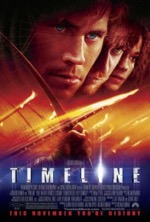
Starring: Paul Walker
November 2003
“Mediocre Romp Through Time”
A faithful (if greatly abridged) adaptation of Michael Crichton’s novel of the same name, Timeline is a fun, popcorn movie that entertains but doesn’t trick you into thinking that it’s a major blockbuster hit…because it’s not. It is, however, a great way to get lost in the past for two hours.
The story breaks down like this: a well-financed tech company (ITC) has discovered a way to send someone back in time. Professor Johnston is trapped in France in the year 1357, and it’s up to his son, Chris, and Chris’ history-buff companions to rescue the professor from a life in the past. To add tension and urgency to their quest, the team only has six hours to retrieve the professor before they are automatically returned to the present day. And, to make matters worse, the group arrives on the day of a massive battle between the English and French armies, and they’re trapped on the loosing side.
There’s no one area of Timeline that’s spectacular, but as a whole, the movie works quite well. The acting is decent, though most of the faces are unfamiliar, save for Paul Walker (2 Fast 2 Furious) and Neil McDonough (Minority Report). The historical costumes, sets and props all look authentic and the directing by Richard Donner (Lethal Weapon) is deft; though, the movie lags in a couple of places. The ending battle sequences are excellent, revealing the more visceral side of combat in the fourteenth century—the catapult shots and flaming arrow scenes were riveting.
If there’s a downside to Timeline, it’s the cursory character development and lack of scientific explanations with regard to the time machine. Granted, there isn’t enough time in a two hour movie to delve into every aspect of how the time machine was built and operates, but the fact that it does exist is treated in such a “by the way” manner that it diminishes its role in the movie and undermines the credibility of the movie as a whole.
In the novel, Crichton takes the time to give a point-by-point explanation of the machine and the science that governs it—the idea of faxing a copy of a person back in time is absolutely brilliant. In the movie, however, that concept is only hinted at and the writers, instead, have chosen to use a wormhole attuned to 1357 as the conduit for transportation to the past. Since the method of time travel is vague and confusing, it’s hard to buy into anything that happens in the past, and that’s the major problem with Timeline. With the complexity of the science involved and a larger ensemble of characters to develop, this is probably one Crichton novel that shouldn’t have been translated into a movie. I suppose time will tell.
Rating: 2 1/2
The Haunted Mansion (PG)
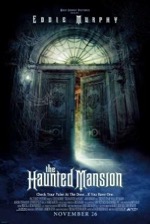
Starring: Eddie Murphy
November 2003
“Too Scary, Not Very Funny”
Based on the classic ride at Disneyland, The Haunted Mansion is a scare-fest that feels more like a glorified attraction than a movie. The scenes, symbols and inside gags from the ride are all here, but The Haunted Mansion seems more like a caricature of itself than a living, breathing entity.
The movie opens with overachieving real estate agent, Jim Evers (Eddie Murphy) visiting a mansion with his wife and two kids. They are met at the front door by a creepy butler named Ramsley, who promptly and unceremoniously escorts the family through the dusty, cobweb-ridden halls to meet his master. Master Gracey is a tortured soul, a shadowy figure who pines over the loss of his wife, Elizabeth, a woman who had a striking resemblance to Evers’ wife.
Things go south when Evers discovers Ramsley’s plot to unite Gracey and Evers’ wife in matrimony in order to break an age-old curse. Evers must brave flying instruments, a haunted graveyard and many other frightening things before he can attempt to thwart the butler’s sinister plan.
The Haunted Mansion is the third movie based on a Disneyland attraction, and is arguably the biggest disappointment of the lot. The trailer promises a light and comical joyride, but the actual movie is much darker in tone and isn’t all that funny. When it comes to jokes and humorous dialogue, there’s nothing fresh in Murphy’s repertoire; in fact, his one-liners come off like the donkey gags in Shrek.
The acting is appropriate in The Haunted Mansion, especially the ubiquitous and nefarious Ramsley (Terence Stamp), and the pathos-inducing Master Gracey (Nathaniel Parker). The face in the crystal ball, Madame Leota (Jennifer Tilly), offers some much needed comic relief and she and Murphy’s character play off of each other quite well.
The special effects are top-notch—as would be expected from Disney—but they overshadow the story, stifle character development and suppress any human element in the story, save for the Beauty and the Beast style storybook ending. In the final analysis, The Haunted Mansion is nothing more than a two-hour, live-action version of the Disneyland ride. In fact, the movie resembles the attraction so closely that after you leave the theater, you realize the thrills, chills and spills have been grossly artificial and that you’ve been taken for a ride.
Rating: 2
Master and Commander: The Far Side of the World (PG-13)
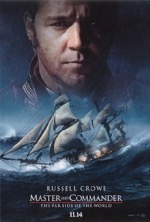
Starring: Russell Crowe
November 2003
“Intelligent Adventure on the High Seas”
In addition to having a long title, Master and Commander is a lengthy film, but is well worth the voyage. The movie is adapted from the first and tenth books in a twenty book series written by Patrick O’Brian, and stars Russell Crowe, who plays Captain “Lucky” Jack Aubrey. Set in 1803, during the Napoleonic Wars, the story captures the gritty realism of life and death on the high seas when naval vessels determined the fate of king and country.
Aubrey, commander of the H.M.S. Surprise, receives orders to pursue and sink the French frigate, Acheron, a vessel with double the hull thickness as the Surprise, which can also outrun and outgun Aubrey’s ship. In an ironic twist, the Surprise is caught off-guard in the movie’s prologue. What ensues is a borderline-obsessive pursuit of the French ship and its wily captain. Several unexpected twists lead up to the battle royal, which decides the outcome of Aubrey’s hell bent mission.
Crowe excels in his portrayal of Captain Aubrey, a character who could easily have been painted with broad, Ahab-like strokes, but remains wholly human—almost vulnerable at times. It has been said that command and compassion is a fool’s mixture, but Aubrey balances both of these attributes in an effective manner: he is honor-bound and resolute, but he also has a wonderful sense of humor and a great camaraderie with his crew.
In assessing Crowe’s performance, the word “natural” immediately comes to mind. Crowe has the uncanny ability to take the leading role in any of these modern epics (Gladiator) and make it his own—seamlessly merging his personality with that of the character he portrays. Joining him on the cruise is Dr. Stephen Maturin, played by Paul Bettany, who also portrayed Crowe’s imaginary roommate in the Academy Award winning, A Beautiful Mind. Maturin is the constant voice of reason in the film and he is both friend and foil to Aubrey. Among the other faces in the crew is Billy Boyd (The Lord of the Rings trilogy), whose turn as a scarred and weatherworn sailor is quite a departure from his role as Pippin the Hobbit.
One of the major driving forces behind Master and Commander is director Peter Weir (Dead Poets Society and The Truman Show), who also co-wrote the screenplay and co-produced the movie. Weir does a wonderful job of capturing the flavor of the early 1800s, while steering clear of any anachronisms—elements out of place or time that seem to mar every other period film that comes out of Hollywood these days. The soundtrack by Iva Davies, Christopher Gordon and Richard Tognetti is sweeping and elegant, brilliantly weaving classical standards into their original score.
The only downside to the film, is that it drags on a bit at times and gradually induces seasickness in the viewer—it isn’t until about the two hour mark that the crew finally steps onto dry land (the pristine Galapagos Islands). Master and Commander is a mature and intelligent sea battle film that, thanks to great acting and directing, is shipshape and Bristol fashion.
Rating: 3
Brother Bear (G)
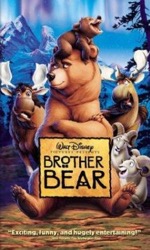
Starring: Joaquin Phoenix
November 2003
“Hackneyed, but Still Heartwarming”
I’ve never been a big fan of talking animal pictures, but Disney has an uncanny knack for making such films not only palatable, but also feasible in most respects. The moment I learned Disney’s Dinosaur (2000) was going to feature talking prehistoric creatures, I thought for sure it would be a flop…I was wrong. Though produced by a different studio, Ice Age, also featuring talking animals from the distant past, surpassed my expectations as well.
So along traipses Brother Bear, an unassuming animal animated feature, which has been reported as the final traditionally hand-drawn animated feature film for Disney (is this true?). Though a bit heavy on the “ancestral spirits,” Brother Bear is heartwarming and has a good message.
Set in the Pacific Northwest, long before Europeans settled in the Americas, Brother Bear is the story of three brothers: Sitka (oldest), Denahi and Kenai (voiced by Joaquin Phoenix). Kenai needs to fulfill a ritual in order to become a man—his totem is the bear of love (a particularly prissy symbol for a young man, which Denahi immediately and mercilessly ridicules him for). One day, while the three brothers are out in the wilderness, a bear shows up, and in a sacrificial act, Sitka draws the bear away from his brothers and plunges to his death. Enraged at his loss, Kenai hunts down the bear and kills it. In that moment, the spirit of Sitka turns Kenai into a bear. After the initial shock, Kenai begrudgingly befriends a cub named Koda. Two twists occur near the end of the film: a vengeful Denahi (who thinks he’s lost two brothers) is stalking Kenai, and Kenai discovers that he was the one who orphaned Koda when he killed the young bear’s mother.
There’s enough Disney magic here to qualify Brother Bear as a success, but it doesn’t hold a paw to Beauty and the Beast or The Lion King. Here are a few reasons why Brother Bear will never be labeled a Disney classic: 1. There are way too many recycled gags from other Disney films, especially Finding Nemo (the “I Spy” game, for instance), 2. The movie is laced with token Phil Collins tunes that contain solid lyrics, but unfortunately lend the feeling that this has all been done before…and it has, 3. Plot devices are hackneyed in Brother Bear. We’ve seen a beast become a man (the order is reversed here). We’ve had a “rite of passage” film with a lion before. We’ve had an overabundance of hilarious sidekicks. The list goes on and on, ad nauseam.
On the positive side, the animation, which at times resembles an oil painting, is really quite good; I especially liked the gimmicks they did inside the glacier and the colorful aurora that had ancestral spirits swimming around in it. The most memorable element of the movie, undoubtedly, is the pair of moose (not meece). Voiced by Strange Brew companions, Rick Moranis and Dave Thomas, the moose brothers are downright hilarious and lend the movie some much-needed comic relief. Without the two moose, the movie might have been unbearable.
Rating: 2 1/2
Radio (PG)
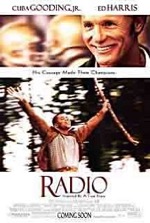
Starring: Cuba Gooding, Jr.
October 2003
“A Triumph of the Human Spirit”
Using the word triumph to describe Radio is no overstatement. Radio delivers on everything it promised in the emotional trailer, plus a great deal more. It’s a genuinely touching story that boasts Oscar-caliber performances by Oscar-winning actors, Cuba Gooding, Jr. and Ed Harris.
The plot isn’t complicated, flashy or filled with mind-blowing twists, but its straightforward simplicity is its greatest attribute. The story is pure and innocent, qualities the title character can readily identify with.
The story takes place in 1976 in a small town in South Carolina, where head football coach, Harold Jones (Harris) spots an odd young man (Gooding, Jr.), who pushes around an old shopping cart that contains various collected items (including a football belonging to Jones’ team). Jones takes interest in the young man and enlists his help on the football team, much to the disapproval of the team, school and community. Jones stands his ground and, over time, becomes a surrogate father for the mentally handicapped youth, whose infectious affection for all styles of music earns him the nickname, “Radio.” What ensues is a journey of self-discovery for both men in this heart-warming tale of human kindness, based on a true story.
Though sports have an important role in the film, this isn’t Remember the Titans or Hoosiers. Whereas sports is the vehicle for telling the story, Radio is all about the flesh and blood characters that breathe life into what otherwise would have been just another modernized re-telling of a glorious championship season of the past.
The pacing of the film is a bit slow at times, but this effect lends itself to the sleepy burg atmosphere of the southern town, and other than this aspect, the directing and writing is very solid. For Radio, James Horner has churned out an original score that is more original than his usual, cookie-cutter drivel (Sneakers, Bicentennial Man and A Beautiful Mind are all virtually the same score), while employing the same ethereal voices in certain motifs.
Radio is a winner because it refuses to lampoon the disability of the mentally challenged lead character, but instead, shows how, in many ways, he is more human than the rest of us “normal” people. Showing clips of the real-life Radio and Coach Jones at the end of the movie was a very nice touch. Radio is an inspiring film that is definitely worth tuning into.
Rating: 3
Runaway Jury (PG-13)
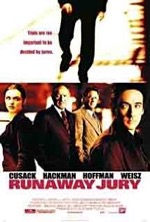
Starring: John Cusack
October 2003
“Taut Thriller with a Good Moral”
Runaway Jury is the latest in a series of John Grisham novels adapted for the silver screen. Runaway Jury is every bit as intense as The Firm and The Pelican Brief, and, like its predecessors, boasts an all-star cast. The word that best sums up the movie is “paranoid.” Everyone in the film seems to be paranoid, and that persistent, pervading emotion soon rubs off on the viewer; you’re never quite sure who is on what side until the very end, which makes Runaway Jury a Grade A legal thriller.
The story begins with a disgruntled employee, recently terminated, returning to his workplace and opening fire on all of his former co-workers. Flash forward to the trial: Wendell Rohr (Dustin Hoffman) is the prosecutor for the plaintiff, a woman widowed by the shooting. Assisting the defense is Rankin Fitch (Gene Hackman), a no-nonsense, self-assured agent who is in league with the gun company that made the weapon used in the shooting. The gun company pays off Fitch to buy a verdict, so he immediately goes to work in his underground intelligence complex, where a full-time staff of highly-trained individuals utilizes high-tech equipment in order to spy on potential jurors. Based on profiles and other Intel, Fitch guides the defense attorney through the jury selection process, weeding out anyone who might be a threat to the verdict they desire. The jury is selected, but unbeknownst to Fitch, someone knows what he’s up to and has placed a wild card in the jury, someone with enough influence and charisma to swing the jury one way or the other. The wild card is Nicholas Easter (Jon Cusack), and his girlfriend, Marlee (Rachel Weisz), is the one who is throwing a monkey wrench into Fitch’s plans. She presents a deal to Rohr and Fitch—a promise to swing the jury their way for a price. Rohr has integrity and refuses the deal, but Fitch, hell-bent to win at any cost, agrees to pay Marlee. This decision sets a series of events into play that leads to a major twist and unexpected verdict.
Runaway Jury is a riveting tale that owes a lot to its rich source material. Beyond the intricate plot, the acting is nothing short of stellar and features the first big screen appearance of long-time friends, Hackman and Hoffman. The scene they share is absolutely electrifying; both men engage in a war of words that is unrivaled in recent motion picture history. Cusack is very good in his everyman role as Nicholas Easter and the rest of the supporting cast does a phenomenal job, especially Jeremy Piven as Rohr’s assistant.
There’s a great David vs. Goliath moment at the end of the film, where men and women of good conscience stand up to the greedy gun company. The movie has a good moral and a great message, but the jury is still out as to how well it will do at the box office.
Rating: 3
Intolerable Cruelty (PG-13)
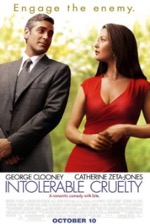
Starring: George Clooney
October 2003
“Undeniable Stupidity”
Intolerable Cruelty truly is the best phrase to describe this film, because, after fifteen minutes of watching this mind-numbing display of unbridled avarice and over-the-top acting, you’re ready to sign your life away just to get out of the theater. George Clooney plays shifty divorce lawyer, Miles Massey, who never looses a case until he looses his heart to his kindred spirit, Marilyn Rexroth, an alluring divorcee portrayed by Catherine Zeta-Jones.
As the movie progresses, it gets zanier by the minute as Rexroth leaves behind a trail of affluent, but easy-to-dupe husbands who make her filthy rich with prenups. As kismet would have it, Massey marries Rexroth, and, in a display of undying love, he rips up the prenup. on their honeymoon night. Rexroth betrays Massey, of course, and leaves him lovelorn and homicidal; but in the end, she comes to her senses and decides to return to Massey. And they live happily ever after…or something like that.
Intolerable Cruelty leaves you searching for a meaning behind its quirky and murky plot. It flirts with a message (love’s supremacy over the lust for money), but the story is so muddied by ambition, deception and shady morality that anything virtuous is undetectable when looking back on the film as a whole.
There’s a ton of foul language in the movie and the dialogue, when clean, is excessively stilted, employing quotes from Shakespeare and other literary giants in order to convey basic concepts. This renders the movie verbose, trite and unreachable. The movie tries to be funny, but it fails miserably—like the “sitting before the judge before” scene with Edward Herman as the cornball, Mr. Rexroth.
The major problem with the film is its lack of a protagonist—Massey’s exploits are hardly laudable and Marilyn Rexroth is a manipulative minx. And we’re supposed to cheer when they finally get together? What were Clooney and Zeta-Jones thinking when they accepted this script? Intolerable Cruelty is a terrible waste of star power and an egregious waste of time.
Rating: 1 1/2
Out of Time (PG-13)
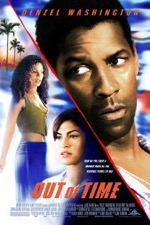
Starring: Denzel Washington
October 2003
“Thrill a Minute With a Touch of Humor”
Denzel doesn’t disappoint. Not much of a revelation, I know, but you would think that somewhere along the way, the Academy award-winning actor would trip up and select a project that would miss its target. In the early stages of the film, I thought this might be just such a time; the movie was very slow out of the starting blocks and featured Denzel, playing the chief of police in a small, shoreline town in Florida, in the throes of a divorce while messing around with another man’s wife—very uncharacteristic of the actor who’s brought us so many heroic roles in the past (Crimson Tide, The Pelican Brief, Remember the Titans and Antoine Fisher just to name a few).
Denzel’s Matt Whitlock makes one bad choice after another in the film’s prologue; he plans to steal away with his steamy paramour—who claims to be the victim of both an abusive husband and a fatal form of cancer—by using evidence money from a recent drug bust that had elevated his status to local hero. When Whitlock’s mistress and her husband are killed in an arson fire—and he’s spotted at the scene of the crime, events spiral downward at an alarming pace.
Putting out one brushfire after the next, Whitlock attempts to discover who framed him, while keeping his own police department and the feds. off balance just long enough for him to find the evidence that will exonerate him. After a series of nail-biting episodes in which Whitlock’s indicting affair is nearly revealed, and several genuine, on-the-edge-of-your-seat action sequences, Whitlock discovers the mastermind behind the elaborate trap and realizes that he may have committed one mistake too many.
As mentioned, Denzel is pitch-perfect as the protagonist, but he is surrounded by some wonderful talent, not the least of which is Dean Cain (Lois & Clark) as the rival husband, Sanaa Lathan as Whitlock’s mistress, Eva Mendes (2 Fast 2 Furious) as his estranged wife and his delightfully quirky side-kick, played by John Billingsley (Star Trek: Enterprise), who delivered the most memorable line in the movie, “A beer in hand is worth two in the fridge.”
It probably won’t go down as movie of the year in any category, but Out of Time is a great popcorn flick that entertains and raises the blood pressure all at the same time.
Rating: 3
Under the Tuscan Sun (PG-13)
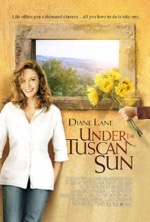
Starring: Diane Lane
September 2003
“Average Romance Shot in Timeless Tuscany”
Under the Tuscan Sun is a heartwarming romance that, mercifully, balances out the love story with artistic and dramatic panache, along with touching moments of genuine humanity. The movie’s success can be attributed to Diane Lane’s wonderfully organic performance and to the awe-inspiring Tuscany countryside which serves as breathtaking backdrop and nonhuman star in the film. Audrey Wells directed the movie and also wrote the screenplay, which is based on the memoirs of Frances Mayes.
Recently divorced, Frances (Lane) gets a wild hair and decides to relocate to Italy. Purchasing a modest home in a Tuscany villa, Frances finds the time for artistic pursuits as well as hosting parties when not renovating and maintaining her casa. After her heart has had the proper time to heal, Frances visits the coast and finds the man of her dreams—but even the perfect man, Frances learns, has his share of sordid secrets.
The movie’s pacing can make an insomniac drowsy, but Lane skillfully chews enough scenery to hold the audiences’ attention; the unconventional love story further aids in sustaining viewer interest. Under the Tuscan Sun is made memorable by the stunningly scintillating location work, but also by the uplifting story about a courageous young woman who ends one chapter of her life and boldly begins a new chapter on a different continent. Hope springs eternal…especially in idyllic Tuscany.
Rating: 2
Secondhand Lions (PG)
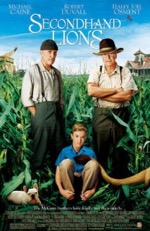
Starring: Haley Joel Osment
September 2003
“Come See This Comely Coming-of-Age Tale Firsthand”
Secondhand Lions, a lighthearted tale of self-discovery, focuses on prepubescent Walter (Haley Joel Osment) and his two eccentric uncles, Garth (Michael Caine) and Hub (Robert Duvall).
The movie opens with Walter’s promiscuous mom (Kyra Sedgewick) dumping him off at his uncles’ farm for the summer while she goes off to “get a job” (translation: have a wild time) in Vegas. Garth and Hub’s daily routine involves sitting on a porch swing with rifles and taking potshots at any salesperson bold or foolish enough to approach their farmhouse. Appalled by their declared open season on salesmen, Walter challenges his uncles to find out what the peddlers are selling before filling their britches with buckshot and to spend some of their rusting fortune on items of interest.
Taking Walter’s advice, Garth and Hub purchase a secondhand lion, which they intend to hunt in a nearby cornfield. When the lion arrives, however, they discover that this king of beasts is docile and has one paw in the grave. Dispirited, the aging men feel even more obsolete than before; hunting a lion would have transported them back to the glories of their youth when they fought in wars and lived life on the edge. By summer’s end, Walter’s uncles teach him how to become a man and Walter teaches his uncles how to enjoy life again by being more spontaneous.
Caine and Duvall deliver superlative performances and Osment continues to amaze with the depth and maturity of his craft for one so young. Though Josh Lucas, as the adult Walter, looks nothing like Osment, the movie’s wrap-up is heartwarming and has an excellent payoff. Secondhand Lions is a family-friendly drama that deals with coming-of-age and old age in a meaningful, yet whimsical, manner. It’ll probably fly under the radar, but this is one film that shouldn’t be missed.
Rating: 2 1/2
The Fighting Temptations (PG-13)
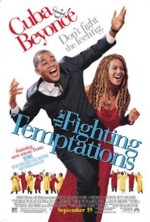
Starring: Cuba Gooding, Jr.
September 2003
“A Class Act, But No Sister Act”
Darrin Fox (Cuba Gooding, Jr.) is a fast talker who manages to work his way up the ladder to an enviable position at a marketing firm in New York City. Just when things are going great in his life, Darrin receives news that his beloved aunt has passed away. Returning to his hometown of Montecarlo, GA—the quintessential southern burg—Darrin is reunited with friends and family, whose speech, clothing and habits throw him into immediate culture shock; his roots have come back to haunt him.
Darrin stands to gain a great deal of money from his aunt’s will, but her dying wish contains one condition—Darrin must conduct the Baptist choir and win the annual music contest in order to receive his inheritance. Darrin, who knows next to nothing about music (but can fake his way through anything), is dealt a bad hand from the start; the choir contains half a dozen average vocalists, a wizened organ player and a controlling pastor’s wife who resists him at every turn.
Darrin enlists the help of his childhood sweetheart, Lilly (Beyonce Knowles), who has the voice of an angel, but according to the pastor’s wife, sings the devil’s music in the local bar. This is just the first of many obstacles Darrin must hurdle in order to build a choir and get it ready for the competition. When circumstances go from bad to worse, Darrin tucks tail and heads back to his comfortable life in the Big Apple. But he soon realizes it’s not about the money anymore; it’s about the relationships he’s built with his choir and the commitment he made to them and his departed aunt. Darrin returns with a newfound passion and leads his group in a rousing number at the competition. If you’ve seen Sister Act, you can guess the end from here.
And speaking of Sister Act, there are more than just a few similarities between that breakout blockbuster and The Fighting Temptations, but this new version of the “average church choir wins the big music competition” plot doesn’t hold a hymnal to the Whoopi Goldberg comedy classic. Cuba Gooding Jr. is believable in the way he gradually comes around, leaving behind his big city attitude and reverting to the caring and honest person he was in his youth. Beyonce Knowles hits her marks and says her lines, but it’s clear that her incredible voice is the only reason she’s in the movie.
There are some wonderful cameos in the film: Steve Harvey’s radio D.J. provides several moments of hilarity and the Rev. Shirley Caesar and rapper T-Bone lend their talents to the final show-stopping number. And let’s not forget the men in the orange jumpsuits—the inmates that Darrin recruits for his makeshift choir. Some of the movie’s funniest moments involve these upstanding (though cuffed) choir members.
The Fighting Temptations isn’t the greatest movie of its kind, but it is inspiring and features some toe tapping, head-bobbing and smile-raising Gospel music.
Rating: 2 1/2
S.W.A.T. (PG-13)
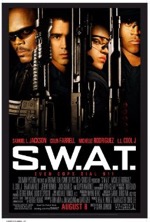
Starring: Samuel L. Jackson
August 2003
“By the Book Update of 70’s Police Drama”
S.W.A.T. is an acronym that stands for Special Weapons and Tactics. S.W.A.T. is also the name of a short-lived television series that ran during the 1975-1976 season and starred Steve Forrest and Robert Urich. The new S.W.A.T. movie has barrowed many of the names and archetypes from the original show, but has wisely transported the setting forward several decades and given the story an appropriately edgier tone.
In some respects, S.W.A.T. is little more than a glorified TV show with big-name actors, and this should come as no surprise since the movie’s director, Clark Johnson, is best known for his work on small screen hits like Homicide: Life on the Street and The Shield. Even though the movie closely resembles a standard police procedural, it’s still considerably better than it would have been had the producers committed the cinematic crime of adopting the style and milieu of the TV series: 70’s crime dramas were notorious for depicting police officers merely as caricatures of real cops, as virtual superheroes who were impervious to error, corruption or bullets.
Here, thankfully, the characters are a little more three-dimensional, if a little doughy in the middle. Samuel L. Jackson portrays hard-nosed Sgt. Dan “Hondo” Harrelson and Colin Ferrell plays debased officer, Jim Street, a man who desperately strives to earn Harrelson’s acceptance and thereby find redemption for a past mistake that has tarnished his record and reputation. In the Sydney Bristow era, it’s become a prerequisite for an action movie to feature at least one gorgeous, butt-kicking chica, and in S.W.A.T. we have Michelle Rodriguez (The Fast and the Furious), who embodies the tough-as-nails officer, Chris Sanchez. Rounding out the cast is LL Cool J as Deacon “Deke” Kay and Olivier Martinez as French baddie, Alex Montel, a loathsome tycoon who offers a $100 million reward to anyone who breaks him out of prison.
Most of the movie’s action scenes are similar those you’d see on primetime TV with one major exception…the heart-stopping sequence where Montel’s plane crash-lands on a four lane bridge and bullets start flying like snowflakes in a blizzard. Though I had hoped to see more scenes of this caliber throughout the movie, this pulse pounding sequence is, by itself, worth the price of admission. All things considered, S.W.A.T. is an admirable attempt at graduating a TV series to the big screen and features gritty realism, believable characters and a sobering reminder of how law enforcement officers all-too-frequently pay the price for our enduring security and freedom.
Rating: 2 1/2
Freaky Friday (PG)
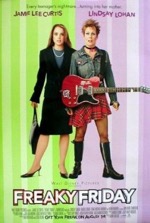
Starring: Jamie Lee Curtis
August 2003
“Modern Remake Lacks Heart”
As far as remakes go, this was an entertaining, if uninspired, effort. The main question that preoccupies the film isn’t whether or not Freaky Friday is better than the original, but why it was necessary to update it at all. The first Freaky Friday, with Barbara Harris and Jodi Foster was wildly entertaining and deserved the right to become a stand-alone classic. Music/hair/clothing styles have all changed over the years, but other than modern trappings, this new movie is virtually identical to its “groovy” predecessor.
The movie opens with the classic mother vs. daughter battle, which escalates at a Chinese restaurant. The Asian proprietor slips the arguing pair two fortune cookies, which magically switches the mother’s soul into the daughter’s body, and vice versa.
A lot of gags ensue the next day as the two women try to switch back (by running and slamming into each other), and when Annabel’s mother, Ellen, goes to school while Annabel embarks on a shopping spree with her mother’s credit cards. These fish-out-of-water scenes (like when Ellen dresses like her daughter and hitches a ride on a motorcycle, or when Annabel destroys the psyches of her mom’s mental patients), become the meat of the story, but it’s not until the two women make peace and show respect to each other that the farcial curse is finally broken and the film comes to a heart-warming climax.
There’s a lovely scene at the end of the film where Annabel thinks of Ellen’s happiness before her own, and gives her blessing to her mother’s union to her new stepfather (Mark Harmon). It’s the only point in the film that I emotionally connected with the characters and thought that, just perhaps, there really was a story amid the flowing fountain of fluff.
The acting in the movie was solid enough; Jamie Lee Curtis was convincing as the uptight, killjoy, Ellen, and Lindsey Lohan (The Parent Trap) was pitch-perfect in her portrayal of a modern teenage girl who wages an emotional tug-of-war with her overbearing mother.
There’s no doubting that this new Freaky Friday is a load of good, clean fun, which will introduce a new generation to this “trading places” tale. But, in the final analysis, the original had more charm than this modern update.
Rating: 2 1/2
Seabiscuit (PG-13)
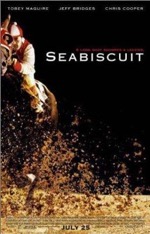
Starring: Tobey Maguire
July 2003
“A Truly Inspirational Triumph”
The only word that readily comes to mind when reflecting upon Seabiscuit is “exquisite.” This is an exquisitely crafted, directed, acted and written film. Based upon the true story and the popular book by Laura Hillenbrand, Seabiscuit tells the story of three individuals and how their lives eventually intersect in wonderful, and sometimes unexpected, ways.
The story picks up in 1910, a time of prosperity for Charles Howard (Jeff Bridges), entrepreneur and car salesman. Life suddenly takes a left turn when his young son drives one of his cars off the cliff and his wife leaves him a short time later. Charles looses nearly everything when the Great Depression hits—no one can afford to buy cars anymore.
But, Charles’ luck changes when he takes a vacation to Mexico; he meets a new woman at the horse races and wins her heart along with a lot of cash. Charles’ life is forever changed when he meets hotheaded jockey, Red Pollard (Tobey Maguire) and an old, eccentric horse trainer, Tom Smith (Chris Cooper), outside the horse track. Converting his car shed into a stable, Charles forges ahead in a new business venture and begins racing Red on a horse named Seabiscuit. They win some small-time races, but Charles has his sights set on bigger prey; he baits the owner of War Admiral, one of the fastest horses in the country, into racing against Seabiscuit—the contest is akin to David and Goliath (or the Tortoise and the Hare). So Charles enters the high-stakes race with a horse that’s too short, a jockey that’s too tall and a trainer that’s too old. The race is one for the history books…truly inspiring.
The writing and directing is exceptional in Seabiscuit, but the acting is nothing short of stellar. Jeff Bridges plays salesman Charles Howard to the hilt; the man is so charismatic and charming, he could probably sell a rancher his own cow. The speeches he delivers are so rousing and ennobling that you have to resist the urge to jump up in the theater and yell in agreement.
Chris Cooper (my vote for best supporting actor-2003) is so natural, so likeable and so pitch-perfect in his performance, that it’s impossible to see any other actor in his role. His character is the sage in the movie, delivering didactic delicacies like, “Just because something’s broken doesn’t mean you throw it away.”
If Cooper represents the movie’s wisdom and experience, Tobey McGuire is its heart and soul. Fresh off his Spider-Man high, McGuire’s turn as the tortured jockey is believable and touching. Horse and rider both know a thing or two about pain and that background of brokenness is the common bond between man and animal. It’s this brand of empathy that makes the pair so in tune with each other and so formidable on the track.
The quirkiest, most hilarious character in the movie, undoubtedly, is William H. Macy’s radio announcer, whose flair for mile-a-minute speaking, incisive one-liners and variety show sound effects really lightens the otherwise somber and serious tone of the film. Though his screen time is limited, Macy’s performance is also worthy of Oscar consideration.
Framing the movie historically are snippets of David McCullough’s Seabiscuit documentary for PBS. These historical vignettes, interspersed throughout the movie, serve as segues but also give the film added depth and authenticity. A finely crafted film, Seabiscuit is an emotional journey well worth taking.
Rating: 3 1/2
Lara Croft Tomb Raider: The Cradle of Life (PG-13)
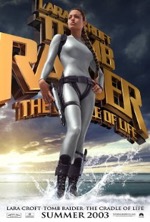
Starring: Angelina Jolie
July 2003
“Second Time Isn’t the Charm”
There’s an old saying: “Fool me once, shame on you. Fool me twice, shame on me.” I’m ashamed to say, that for the second time, I fell for Tomb Raider’s alluring promise of a summer blockbuster that would thrill and entertain. The movie did neither.
The prize of great worth this time around is Pandora’s Box, which will reveal the origins of life on earth when opened. In a plot that mimics the other Raiders with Harrison Ford, but has none of the panache of that action/adventure classic, Lara Croft seeks an amber orb that will reveal the location of the mysterious “Cradle of Life,” the resting place of the mystical Pandora’s Box.
As the story would demand, the orb falls into the wrong hands, but Croft recovers it and kicks the villain into a pool of acid. The only twist: her new hunk decides he wants to open Pandora’s Box, and ultimately, Croft has to kill him to prevent the history of the universe from being tampered with; she resists the urge to open the box, something the fabled Pandora couldn’t. What a hero that Lara Croft is!
As mentioned earlier, the plot is so contrived, that the movie almost becomes a parody of itself, treating myth as fact and creating its own reality in the process. The action sequences were a bit blasé, even when compared to the original Tomb Raider, and most of the dialogue could have been delivered more expressively by cardboard stand-ups.
If there’s anything positive in the film, it’s that Croft’s outfits aren’t as skimpy and gratuitous as in the last film, and with the exception of a brief bedroom vignette, Tomb Raider is a fairly clean movie; if not a bit graphic at times.
So, now the question is, “Will there be another Tomb Raider, or will the franchise become just another archaeological oddity?”
Rating: 1 1/2
The League of Extraordinary Gentleman (PG-13)
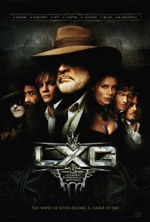
Starring: Sean Connery
July 2003
“More than Ordinary, Less than Extraordinary”
I’m just going to go ahead and admit it: I’m a sucker for this kind of movie. One of my favorite comedies of all time, Mystery Men, is another example (though radically different in theme and tone) of this “hodgepodge of heroes” concept. There’s just something about a team of misfits coming together and using their various talents to kick the bad guy’s butt that just really appeals to me.
A masked villain, know as the Phantom, and his cronies, have been wreaking havoc in England and other parts of Europe, employing a fleet of über-tanks, automatic rifles, armored suits and flame-throwers; all impressive weaponry for the late 1800’s. To defend Her Majesty’s homeland, a team of amazing individuals is assembled, lead by the redoubtable—if slightly doting—Allan Quatermain (Sean Connery). In addition to the hunter extraordinaire, the team is comprised of Dorian Gray (Stuart Townsend), Mina “Vampiress” Harker (Peta Wilson), Captain Nemo (Naseeruddin Shah), the Invisible Man (Tony Curran), Tom Sawyer (Shane West) and Dr. Jekyll/Mr. Hyde (Jason Flemyng).
Once assembled, the team is immediately ambushed by the Phantom in Dr. Gray’s mansion. When met by overwhelming resistance by the League, the Phantom flees, and the chase is on. Aboard Captain Nemo’s submarine, Nautilus (one of the most creative elements in the film), we are allowed a glimpse into the minds of several characters, most notably, Dr. Jekyll/Mr. Hyde; a tortured figure that simultaneously produces fear and pathos in the viewer—he’s the most fully-realized character in the movie. After thwarting the Phantom’s plans to destroy Venice from below, the group discovers that the League is a sham and that Dr. Gray obtained blood samples from each member of the team on their voyage. The Phantom plans to clone the League and use their evil, alter egos to overthrow all of Europe. The real League arrive at a snow-covered island (the Invisible Man, who had stowed away aboard an enemy craft, leads the Nautilus to the villain’s lair), infiltrate the Phantom’s hidden facility (part factory, part lab), destroy their D.N.A. and polish off all the bad guys, but not before Quatermain is killed from a gun shot.
LXG is a solid hit, but it falls far short of a home run. The movie’s climax is heart stopping at times, but the wrap-up is contrived and utterly meaningless (unless the witch doctor raises Quatermain from the dead just in time for a sequel). Even with the disappointing dénouement, the biggest tragedy in the film is that it has so much unfulfilled potential. The depth and complexity of this alternate history, paired with fascinating characters and an overabundance of creativity should have amounted to a much finer end result. As things are, LXG is a summer popcorn flick that entertains, but fails to create a league of its own.
Rating: 2 1/2
Pirates of the Caribbean (PG-13)
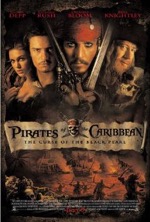
Starring: Johnny Depp
July 2003
“Slow to Sail, but Worth the Voyage”
You can almost smell cannon smoke, can almost feel the exhilaration of being in a sword duel and can almost feel the thrill of being on the open sea in Disney’s Pirates of the Caribbean. The key word here is “almost.” Pirates of the Caribbean is almost the swashbuckling adventure that you want it to be, but not quite. The plot takes a while to get out of the bay, and when it finally reaches open water, the few twists that exist in the script leave you with the feeling that you almost had a good time.
The movie opens with pirate Captain Jack Sparrow (Johnny Depp) scheming to steal a ship, while simultaneously attempting to give the Red Coats the slip. He crosses blades with Will Turner (Orlando Bloom), a blacksmith apprentice, and son of a notorious pirate. Will, eager to leave the blacksmith shop and become a pirate, joins Jack after the two strike up a tenuous friendship. The pair of pirates steal a British ship and pursue the grossly-fabled and greatly-feared, Black Pearl—a pirate ship with sails that look like Swiss Cheese and swabbies that turn into skeletons when bathed in moonlight.
The skipper of the Pearl, Captain Barbossa (Geoffrey Rush), is in pursuit of the last piece of gold that came from Cortez’ cache. The curse that holds Barbossa and his crew in a pseudo-limbo state—neither living, nor dead—will be lifted when the last medallion, covered with the blood of a member of a certain pirate family, is returned to the chest. After several ship battles and several sword fights, it is discovered that Will, son of infamous Bootstrap Bill, is the only one that can break the curse. Barbossa’s bony men ambush a British ship, which only has a skeleton crew aboard and make short work of the Red Coats (bullets don’t kill skeletons). In a climactic moment, when Barbossa and Jack are locked in an epic duel, Will cuts his hand and tosses the blood-spattered gold piece into the brimming treasure chest and Jack shoots Barbossa with his gun. Barbossa falls over dead, and at that moment, the tide is turned on the ship, where Barbossa’s crew is swiftly defeated.
Pirates of the Caribbean succeeds on several levels; the art direction and costuming is superb. The effects are great, as would be expected, and the acting is very good. In fact, Johnny Depp’s performance is so superior as the nutty, quirky, shifty Jack Sparrow (that’s “Captain Jack Sparrow,” thank you), that it’s no stretch to say that the movie would have flopped without him. Depp infuses the flick with a certain degree of irreverence and levity that would have been sorely missed in his absence.
Thankfully, the film is devoid of any sayings or references that are out of time or place (I call them Disneyisms), which have been employed far too often in most modern Disney movies. On the whole, the dialogue if fairly true to the time period it represents and is consistently humorous.
Pirates of the Caribbean is fun, summer entertainment that should please a large audience, even if it fails to deliver the best story possible. I guess dead men aren’t the only ones who can’t tell tales.
Rating: 2 1/2
The Hulk (PG-13)
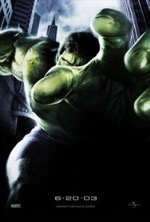
Starring: Eric Bana
June 2003
“Dark, Depressing, Distracting and Disappointing”
The Hulk is a big, jumbled mess that is so preoccupied with being the next big-screen sensation that it fails to entertain in nearly every way. Ang Lee’s avant-garde directing style is so distracting (relentlessly accosting the viewer’s eyes with a variety of wipes, split-screen or multi-panel effects), that it should be mandatory for the box office tellers to hand out two aspirin with each movie ticket.
This version of The Hulk is based on the comic book, not the 70’s TV show, and is the worse for it. In the TV version, Bruce Banner would transform into the Hulk if he broke his finger, or if he was attacked, or if he saw someone being victimized and “got angry.” In the movie, Bruce has no such catalysts for transformation; but becomes the Hulk when “repressed memories” (puh-leez) from his childhood trigger a physiological response and turn him into the not-so-jolly green giant.
The comic incarnation established that the Hulk has the ability to leap/bound three miles at a time, and whereas this is probably really cool on the page, it’s cheesy as heck on the silver screen. To make matters worse, the Hulk jumps from one mountaintop to another for close to five minutes, producing dizziness and thoughts such as, “Okay, I get the point already!” Another trait that doesn’t lend itself to the believability of the film is the Hulk’s immense size; he’s several feet taller than his comic book alter ego and simply looks too large.
The film’s pacing is excruciatingly slow, especially in the beginning, where the audience has to wade through nearly an hour of exposition before the Hulk’s first mutation, and most of the back-story is boring and confusing. Good storytelling involves showing, not telling, but The Hulk takes this principle to absurd extents…way too many things are left unexplained. Like, was there really a nuclear blast in the past or was that just a part of little Bruce’s horrific memories? Or, what in the world does David Banner turn into at the end of the movie (some kind of ectoplasmic balloon)?
If there’s a bright spot in The Hulk it’s the acting. Eric Bana is surprisingly convincing as the Hulk; he doesn’t allow over-emotionalism to stilt his performance. Jennifer Connelly is good as Betsy Ross, but her role certainly isn’t Oscar-worthy, and her on-screen father, General Ross, is played to the hilt by the rugged, no-nonsense, Sam Elliot. Nick Nolte portrays David Banner (or is he just playing himself?), a mad-scientist type who clearly has some mental and emotional issues to work through—kudos to the casting director.
The biggest failure in The Hulk is the disservice it pays to its target audience—young boys. The Hulk never once uses his super-human abilities for constructive purposes, but rather, destroys anything and everything in sight without the slightest consideration or compunction: there’s nothing heroic in the Hulk’s actions and he becomes little more than an oversized thug in the movie. Seething anger and unbridled hatred fuel this version of the Hulk, and as such, makes him a poor role model for kids.
The final word: as corny as it was, the 70’s TV show was infinitely more believable, and ironically, more entertaining than this new, unimpressive knockoff.
Rating: 1
Hollywood Homicide (PG-13)
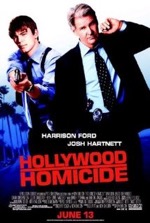
Starring: Harrison Ford
June 2003
“Glorified Cop Show Misses the Target”
Hollywood Homicide feels like a big-screen version of the new Dragnet TV series. Both are based in L.A., both feature cops working the homicide beat and both have a seasoned veteran and a young-buck sidekick. All of these similarities to Dragnet and other cop shows hamstring the picture, and any new and fresh ideas the writers hope to achieve seem trite by comparison.
The story begins with a murder at a dance club and the plot slowly unravels, linking the first murder to another double murder. As they investigate the case, Detective Joe Gavilan (Harrison Ford), who sells real estate on the side, tries to foist a lemon on anyone who will buy it, while his partner, K. C. Calden (Josh Hartnett), teaches a yoga class and schmoozes with every woman in sight. Joe engages in some unorthodox methods of investigation (one of his informants is a cross-dresser) and K.C. begins to consider a career in acting. The murders lead back to a local record producer, who evades the two detectives until he meets an untimely demise. An accomplice to the murders proves to be the man who killed K.C.’s father, and rather than taking revenge, K.C. records the man’s confession on a hidden cassette recorder. In the end, Joe sells the house and K.C. makes his acting debut. And they all live happily ever after—if that’s possible to do as a cop in L.A.
Hollywood Homicide takes an eternity to get going, and when it finally does, it doesn’t deliver all that big of a punch. Even by the second act, it’s pretty obvious who the killer is, and as a villain, the record producer is severely underdeveloped, and doesn’t really evoke the feelings of loathing or fear that a good antagonist should convey.
The last quarter of the movie is one big car chase and is embarrassingly reminiscent of an 80’s cop show. At first, it’s nice to finally see some action, but as the chase sequence drags on and on, the urge to look for stray Skittles on the floor becomes a viable alternative to the mind-numbing action on the screen.
The only novel idea in the movie is a cop selling real estate as a part-time job, an idea that gets worn out from overuse. And as for Ford, why did he select this role? His last few script choices have been average at best (Air Force One was his last big screen triumph). Here, he tries to be an action star, but doesn’t quite pull it off. He tries to be funny, but only lands about half of his jokes. And his cell phone in the movie is just downright annoying (beating the first few bars of the Temptation’s “My Girl” into the ground). Unlike some naysayers, I believe there’s still gas in the old Ford, but he needs to choose better films to act in (like the forthcoming Indiana Jones IV).
Hollywood Homicide is like a falling star in Tinseltown; it shows for two hours, but is gone in sixty seconds.
Rating: 2
The Italian Job (PG-13)
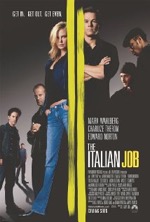
Starring: Mark Wahlberg
May 2003
“An Average Job, With Very Few Surprises”
“There is no honor among thieves.” The age-old saying proves very true in The Italian Job, an action-packed heist movie where routing for the bad guys is en vogue (because the other bad guys are much worse).
The movie begins with the thieves, led by Charlie (Mark Wahlberg) and John (Donald Sutherland), stealing a safe filled with 35 million in gold bars. The score goes down without a hitch until one of the members of the team, Steve (Edward Norton), double-crosses them, shoots John, takes all of the booty and kills the rest of the team (or so he thinks).
A year later, Charlie reassembles the original team (sans the deceased John) in L.A., with John’s daughter (Charlize Theron) thrown in for good measure, and they formulate a plan to get their gold back. Steve has purchased a plush mansion and has filled it with the dream items from all of the original team members (trophies that signify his conquest over them). Steve is smart and devious, but Charlie, with the help of his colorful and technical team, proves to be more than a match for the nefarious thief; and after a series of plot twists and action sequences, Charlie and his crew get their gold back.
The word that best describes The Italian Job is “average.” It’s not a bad movie, but it’s nothing revolutionary either; and Mark Wahlberg’s calculated under-acting only adds to the film’s mediocrity. The movie isn’t devoid of fun, however; the different members of Charlie’s team are quite entertaining, especially Lyle (Seth Green), a young man who claims to have invented Napster (he says his college roommate stole the program while he was asleep on his keyboard). Lyle fancies himself as “The Napster,” and is the technical genius of the group, deftly navigating his way through a self-made computer program that can hack into L.A.’s transportation system and re-route traffic anywhere he wants.
The team is assembled in an amusing, almost Ocean’s 11-like manner, but the moment is short-lived and most of the characters go unnoticed for the rest of the film. Edward Norton plays the perfect weasel-eyed villain and makes you want to reach through the screen and deck him in the face (like everyone else does in the film).
It’s not a complete loss, but in the final analysis, The Italian Job is a pretty average way to spend two hours.
Rating: 2 1/2
Finding Nemo (G)
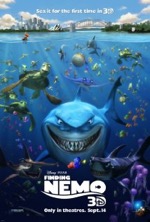
Starring: Albert Brooks
May 2003
“Disney/Pixar Goes ‘Down Under’ the Sea”
Disney’s stalwart animation studio, Pixar, is back in Finding Nemo, and this time they venture under the sea (sorry, no Sebastian this time). As would be expected, the computer-generated effects are jaw dropping and the detail and movement of the underwater creatures is really quite astonishing. The most striking element of Finding Nemo is the vibrant, almost three-dimensional colors that explode from every corner of the screen, like an underwater kaleidoscope.
Finding Nemo begins with a prologue section, which serves as a back-story and sets up the look and theme of the movie. Nemo (Alexander Gould) was the only surviving child of a barracuda raid, which took the life of his mother and turned his father, Marlin (Albert Brooks), into a paranoid and overprotective parent. Flash forward: Nemo, now in his formative, fish years, has none of his father’s hyper-cautious hang-ups and one day strays out too far from the reef. He is immediately captured by a diver and is later set free inside a dentist’s aquarium in Sydney.
Meanwhile, Marlin meets Dory (Ellen Degeneres), who suffers from an insufferable case of short-term memory, and the pair set out on a ponderous, arduous and dangerous journey to find Nemo. Back in the aquarium, Nemo makes some new friends and meets Gill (Willem Dafoe), who’s nearly died several times trying to escape the tank. Nemo is much smaller, however; and manages to stop up the water purifier and affect his escape (through a toilet bowl, of course). By now, the whole ocean knows of Marlin’s plight, and as soon as Nemo hits the open water, it’s only a matter of time before father and son are reunited.
The story is pretty standard fare for Disney, but what distinguishes Finding Nemo is its imagination; like the Sharks Anonymous club, or the minefield of jellyfish, or the copasetic turtles surfing along the East Australian Current. In Finding Nemo, the fish are humanized and the humans are drawn in bland hues with very little detail—there’s no doubting who the stars of the movie are.
Finding Nemo ends a bit abruptly and doesn’t deliver the big climax you would expect (imagine this: a school of barracudas show up right after the reunion and things look hopeless until the three sharks arrive and save the day), but it does leave you with the warm fuzzies. Though it flounders at times, Finding Nemo is a good family picture and should take a bite out of its competition (Sinbad) this summer.
Rating: 2 1/2
Bruce Almighty (PG-13)
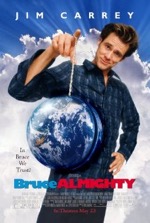
Starring: Jim Carrey
May 2003
“A Comedy That’s Heaven Sent”
What would you do if you were God for a week? This is the lofty question posed by the mildly irreverent, wildly entertaining Bruce Almighty. Bruce Nolan (Jim Carrey) is a disgruntled news reporter (the one who gets all of the boring human interest beats) who suffers one personal tragedy after the next. In one ill-fated day, Bruce looses his job, is beat up by a street gang, has a major fight with his girlfriend and wraps the front end of his car around a light post.
In an animated tantrum right out of the Carrey vault, Bruce takes out his frustrations on the Almighty, yelling at the sky such aspersions as, “the only one around here not doing his job is you.” Next day, Bruce is summoned to an abandoned factory and encounters God (Morgan Freeman), who gives Bruce His job. Bruce can do whatever he wants, but there is one catch: he can’t affect free will.
At first, Bruce takes devilish delight in paying back his enemies and using his newfound powers for personal gain, but he soon discovers that being God—even over a small section of Buffalo, New York—is a much bigger responsibility than he had previously imagined. In the end, Bruce surrenders to God’s will for his life and hands over the reins. Everything returns to normal; he gets his job and girlfriend back, but Bruce has gained a new perspective on life.
Though over-the-top in some instances, Carrey’s performance strikes an emotional chord in this film; he balances comedic silliness with some moments of genuine compassion and sympathy. Morgan Freeman is convincing in his portrayal of God (if not a little laissez faire), and Jennifer Aniston’s performance as Bruce’s girlfriend, Grace, serves as an anchor to the zany protagonist.
Bruce Almighty is a twist on It’s a Wonderful Life (a small clip of the classic movie even appears here), and presents a “what if” scenario that is quite engaging. What could have been a sacrilegious debacle is actually a faith-friendly flick in most respects and actually supports, rather than slams, a Judeo-Christian worldview. Bruce Almighty is a positive and entertaining movie experience; fun and faith affirming is a heavenly combo.
Rating: 2 1/2
X2: X-Men United (PG-13)
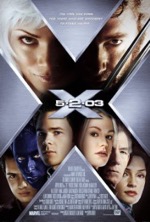
Starring: Patrick Stewart
May 2003
“Mutants Unite…and Go Nowhere”
As sequels go, X 2 succeeds on several levels—most notably with the addition of Nightcrawler (Alan Cumming) and a broader array of special effects—and has established the enduring comic mythos as a viable movie franchise. Clearly paving a path for another sequel (can you say, Phoenix?), X2 has all of the requisite action sequences and pyrotechnics necessary to achieve blockbuster status. But, amid the media hype and fan fervor, a question arises: “Is the sequel as good as the movie it evolved from?”
At the end of the first X-Men movie, Professor Charles Xavier (Patrick Stewart) boldly states to his one-time-friend and archenemy, Magneto (Ian McKellen), that he pities anyone who “comes to that school looking for trouble.” The school in question is the good professor’s academy for gifted youngsters, and someone does show up—with several dozen special ops. troops—and kidnaps a few of the young mutants. The mastermind of the attack is Stryker (Brian Cox), a retired military genius, who later abducts Prof. X and hatches his plot to annihilate all of mutant-kind. Along the way, we discover that fan-favorite, Wolverine (Hugh Jackman), was actually physically altered (implanted with adamantium plating) by Stryker, who unleashes Lady Deathstryke (Kelly Hu) on the lupine warrior, and a whirlwind battle ensues between Wolverine and Stryker’s newest creation. Multiple melees erupt in the film’s climax; a dam breaks, a X-man defects to the dark side and a X-woman meets an untimely demise.
All in all, X2 is an action-packed movie with some cultural relevance and a few moments with a human connection. The “Gee Whiz” factor is quite high on X2, but it fails to capture the clarity and intimacy of the original. The greatest contributor to this problem is the ever-growing pantheon of mutants. My biggest contention with the Batman films was the way the producers/writers packed the sequels with multiple villains, effectively splitting the audiences’ attention, and thereby, diminishing the impact of the antagonists. Here, the movies are overstuffed with good guys—keeping track of names, powers and current locations of the heroes becomes a chore even for the aficionados among us. And ultimately, despite all of the movie’s thrills, chills (Iceman) and spills, X2 never really goes anywhere, but merely opens the door to another chapter in the continuing war between humans and mutants.
X2 is popcorn entertainment that adequately moves the series forward, but hopefully the next mutation will involve a better script.
Rating: 2 1/2
Holes (PG)
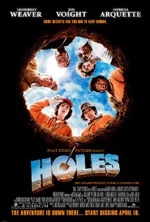
Starring: Shia LaBeouf
April 2003
“Disney Digs up a Gem”
Every once in a while, Disney produces an entertaining, clean, live-action film that makes a hole in one. Though dissimilar in theme, last year’s, The Rookie, would certainly fit into this traditional, inspiration movie mold. This year’s model, Holes, is definitely something new under the sun; and in a summer swarming with sequels, it’s nice to see something fresh and innovative.
Based on the teen novel by Louis Sachar, Holes features an array of new talent, most notably, Shia LaBeouf as Stanley Yelnats and Khleo Thomas as Zero. There are also some other, more recognizable names here, like Sigourney Weaver as the camp warden and Jon Voight as the trigger-happy, sunflower seed gulping, Mr. Sir. The film is also bolstered by a solid screenplay and deft direction by Andrew Davis (The Fugitive).
Men in the Yelnats (Stanley spelled backwards) family have endured a curse for several generations. Young Stanley is in the wrong place at the wrong time and ends up a Camp Greenlake, a juvenile detention facility. To build character, these young men must dig holes all day in the oppressive desert heat, while avoiding snakes, scorpions and the deadly yellow-spotted lizard.
While digging, Stanley discovers an artifact that has an intricate and sordid past—a past that is fleshed out in several historical vignettes that occur at irregular intervals during the middle of the story and serve as an intriguing subplot. Stanley must unravel the mysteries of the past in order to break the familial curse and clear his name.
Holes doesn’t take itself too seriously, and yet, you don’t have to suspend your disbelief to dizzying heights in order for the fictional elements to make sense or feel like they fit in with the overall plot. The movie has a surprisingly solid storyline, and for a movie geared for teens, has far fewer plot holes than most adult movies.
Holes is as refreshing as a rain shower on a hot summer afternoon—an image not lost on the movie—and is a feel-good family flick that anyone can easily dig.
Rating: 3
Anger Management (PG-13)
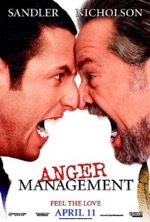
Starring: Jack Nicholson
April 2003
“Somebody Call the Script Doctor…This Film Needs Therapy”
Whenever I watch this brand of movie, I always have to stop and ask myself, “Do people like this really exist?” I suppose they do; archetypes this clearly defined aren’t created in a vacuum…or a test tube. And yet, I’ve never known anyone as easily enraged as Dave Buznik (Adam Sandler) or as certifiable as Dr. Buddy Rydell (Jack Nicholson). The movie’s casting was a no-brainer: Sandler excels at playing selfish, mad-at-the-world types and nobody does psychotic better than Nicholson; together, they’re a disturbing riff on The Odd Couple.
Dave is a mild-mannered businessman who bottles up everything inside and avoids conflict at all costs. In an uncharacteristic act, Dave looses his temper on a jet and later faces charges for his outburst—in order to avoid jail time, he must attend counseling sessions. Buddy, an anger management expert, is assigned the task of rehabilitating Dave, who, of course, claims he doesn’t have an anger problem…that all changes when Buddy’s unorthodox methods start to grate on Dave’s nerves. After finding Dave to be an “extreme” case, the court grants Buddy’s request to move in with Dave so that the psychologist can keep a closer eye on his patient. This doesn’t sit well with Dave or his girlfriend Linda (Marrisa Tomei), and that’s when, as they say, the defecation hits the rotary oscillator.
You’ve seen this movie before…it’s called What About Bob? and stars Bill Murray as a needy patient who stalks his vacationing psychiatrist, Richard Dreyfuss. The roles have been reversed and Buddy’s counseling strategies actually have some merit, but the two plots, at their core, share more than just a passing resemblance. Unfortunately, the same virus that afflicted What About Bob? has also infected Anger Management; namely the unrelenting torrent of screwball humor, melodramatic performances and a plot that borders on the absurd. Dave and Buddy are so dysfunctional that the majority of “normal” audience members will find it hard to identify with the deranged duo, much less sympathize with them. And just who exactly is supposed to be the protagonist here?
Director Peter Segal and writer David Dorfman have offered up a soulless story that flirts with salience but fails to deliver the smallest morsel of meaning. An even larger disappointment is that the movie—a supposed comedy—isn’t even all the funny. The best exchange in the film comes when Dave and Buddy are lying side by side in bed. Buddy offers, “In Europe, it’s not considered unusual for three or more men to share a bed,” to which Dave replies, “That’s why I’m proud to be an American.”
For the updated Miracle on 34th Street (1994), 20th Century Fox, confident they had produced a hit, offered a money back guarantee to disappointed attendees. Why can’t they ever make that kind of offer for a movie like this? After sitting through two hours of Anger Management, I was definitely mad enough to ask for my money back!
Rating: 2
Evelyn (PG)
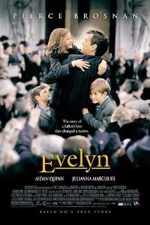
Starring: Pierce Brosnan
March 2003
Amid the deluge of effects-heavy pictures, comes little Evelyn, which marches up to those other movies like David accosting Goliath—an image not lost on this true story of a courageous father who took on the Irish Supreme Court to regain custody of his three children. Brosnan is wonderful in this family affirming and heartwarming tale.
Rating: 3
Gods and Generals (PG-13)

Starring: Stephen Lang
February 2003
Jeff Daniels, Stephen Lang, Robert Duval, Mira Sorvino, Kevin Conway, C. Thomas Howell, Bruce Boxleitner, Billy Campbell; the list of fine actors in the excellent ensemble cast goes on and on and on…much like the movie itself. Weighing in at three hours and forty-five minutes, Gods and Generals is, perhaps, too painstaking in its attention to historical detail—the pacing is a somnambulating lumber and huge sections of the story consist of exceedingly dry narrative. Under Ron Maxwell’s direction, the movie feels like a high-dollar documentary, lacking any kind of synergy; even the paint-by-numbers battle sequences are static (the only exception is when Daniels’ Lt. Col. Chamberlain is prone on the battlefield, frozen in fear as cannon balls and wounded soldiers fall around him all night long). All of Ted Turner’s money (and even a cameo by the financial mogul) couldn’t hoist the movie out of the slough of mediocrity. By movie’s end, I didn’t care which side won the battle; I just wanted a good, long stretch and some fresh air.
Rating: 2
Daredevil (PG-13)
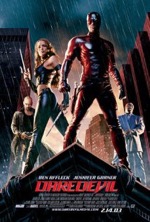
Starring: Ben Affleck
February 2003
The “devil” part is dead on—this character is no hero, seeking his own brand of justice and crossing the line (homicide) that other “true” heroes in the mold of Batman would never entertain, much less tolerate. Character development is as scant as Garner’s outfit and the fight scenes lacked emotional impact.
Rating: 1 1/2
Shanghai Knights (PG-13)
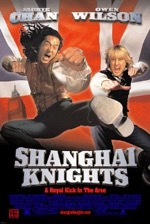
Starring: Jackie Chan
February 2003
Shanghai Knights begins a bit slowly, but picks up the pace when Roy and Chon reach London. There are many amusing twists on historical figures in the film, but too many of the fight sequences are like baby's bottoms. It will be interesting to see which continent the duo lands on in Shanghai Dawn.
Rating: 2 1/2
The Recruit (PG-13)
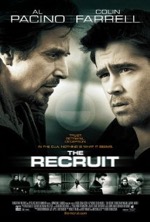
Starring: Al Pacino
January 2003
The Recruit is a solid spy movie that utilizes action sequences and plot twists to the hilt, while leaving the characters a bit underdeveloped. Pacino and Farrell are believable, if not amazing, in their roles. The only downside to the climax is that it leaves you scratching your head on the way out of the theater.
Rating: 2 1/2
The Hours (PG-13)
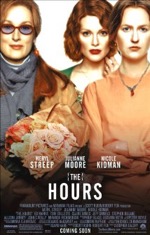
Starring: Meryl Streep
January 2003
Based upon the life and works of Virginia Woolf, The Hours focuses on the themes freedom and love and the issues of suicide and homosexuality. Under solid direction, Kidman, Moore, Streep and (especially) Harris are absolutely brilliant, but the movie is so moody and depressing, it fails in its attempt at being life-affirming.
Rating: 2 1/2
Antwone Fisher (PG-13)
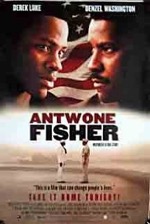
Starring: Derek Luke
January 2003
Denzel Washington’s directorial debut is—was there any doubt—a great piece of cinema. Based on a true story of the title character’s life, Antwone Fisher reveals the challenges of dealing with a painful past and the courage one can find when confronting those issues. Despite some heavy subject matter, Antwone Fisher is a triumph.
Rating: 3
Catch Me if You Can (PG-13)
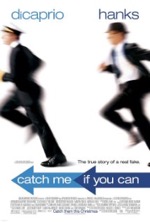
Starring: Leonardo DiCaprio
December 2002
The opening sequence is absolutely brilliant—a throwback to a sixties spy flick. Catch Me if You Can is highly entertaining and Hanks and DiCaprio are spot-on. Catch Me if You Can is so unbelievable at times, that occasionally you have to stop and remind yourself that this actually happened.
Rating: 3
The Lord of the Rings: The Two Towers (PG-13)
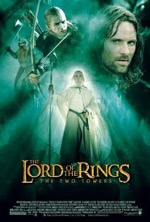
Starring: Elijah Wood
December 2002
“Two Towers, Lots of Power”
The Two Towers picks up right where The Fellowship of the Ring left off—in high gear. Like its predecessor, The Two Towers succeeds on virtually every level and will undoubtedly receive another dozen, or so, Oscar nods. But is it as good as the first?
This middle chapter of J.R.R. Tolkien’s novel trilogy and Peter Jackson’s movie trilogy is somewhat darker than The Fellowship of the Ring, but still retains the nobler, more human, aspects of this epic tale. The Two Towers takes more liberties with the original text than did The Fellowship of the Ring, but it’s difficult to take issue with any of the changes because they’re either creative additions of logical extensions of Tolkien’s cannon.
All of the original cast is back plus a few new faces: Bernard Hill as Theoden, Brad Dourif as Grima Wormtongue, Karl Urban as Eomer, Miranda Otto as Eowyn and Andy Serkis as Gollum, just to name a few.
The movie gracefully bounces back and forth between three storylines: Frodo and Sam’s journey to Mordor, Merry and Pippin’s adventures in the company of Orcs and Ents, and Aragorn, Legolas and Gimli’s pursuit of Merry and Pippin and their valiant efforts in the Battle of Helm’s Deep.
Emerging from the Shadow, Gandalf the White returns in messianic glory, but blends into the scenery a bit too much this time around.
Andy Serkis is brilliant as Gollum, painting every hue in the poor creature’s bipolar existence while simultaneously producing pathos and loathing in the hobbits, as well as the audience. The computer rendering of Gollum is frightening in its realism and clarity—especially around the eyes—and slaughters any previous C.G. character…even Jar Jar. The Ents were another wonderful C.G.I. creation that played a pivotal role in the film: the sacking of Isengard and Saruman’s comeuppance.
The Battle of Helm’s Deep, though tweaked from Tolkien’s original, still embodies the same dread and anxiety, and is simply one of the most visceral and heroic battle scenes ever committed to film. The climax, involving the Black Rider in Osgiliath (both elements, again, a departure from the master’s page) solidifies three things: Faramir’s vulnerability to the enticements of the ring (like his brother, Boromir), Sam’s continued, undying devotion to Frodo and Frodo’s sheer mental exhaustion from bearing the ring.
So, back to an earlier question, is The Two Towers as good as The Fellowship of the Ring? No. But if all sequels were this good, I’d make my permanent residence in a movie theater.
Rating: 3 1/2
Star Trek: Nemesis (PG-13)
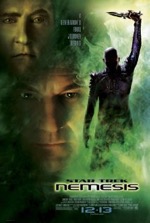
Starring: Patrick Stewart
December 2002
“Trek to the Edge”
Nemesis, the tenth installment in the Trek franchise is anything if not high octane. All the regulars are back (including a meaner-looking Enterprise), and the thrills and twists keep coming at an unrelenting, slightly sub-Star Wars pace. Several major shocks to the system occur near the climax of the film’s near-epic plot, which leave the viewer wallowing in a pool of bittersweet disbelief.
The picture gets out of the starting blocks a bit slowly with a wedding between two principal characters, Riker and Troi (Jonathan Frakes and Mirina Sirtis), and a slogging sub-plot that brings Captain Picard (Patrick Stewart), Data (Brent Spiner) and Worf (Michael Dorn) to the desert planet of Kolarus III, where they encounter the disassembled remains of B-4, an android identical to Data (also played by Spiner).
Meanwhile, a coup d’etat is brewing on Romulus (home to Trek’s first villains), hatched by the warmongering natives on the sister-world, Remus. The Reman Viceroy (Ron Pearlman) once became guardian and protector to a young human boy in the dilithium (think gasoline for starships) mines of his homeworld, where oppressive Romulan guards bred resistance and animosity into the Reman and his young charge, Shinzon.
Now an adult, and self-proclaimed Praetor of Romulus, Shinzon (Tom Hardy) invites Picard and the Enterprise to the new Romulus under a banner of peace and under the watchful gaze of the Viceroy and his “predator” warbird, Scimitar. After a vis-à-vis fraught with tension, Shinzon is revealed as Picard’s clone—a failed experiment of the Romulan government, which intended to swap Picard with Shinzon when he was of age.
Events escalate when Shinzon—now rapidly aging—reveals his plot to annihilate the earth with outlawed thalaron radiation. A final showdown ensues between the Enterprise, the invisible Scimitar and some unexpected guests.
Nemesis is a grand Trek, painted on a large canvas. It’s fairly easy to detect plot and tone similarities between this film and screenwriter John Logan’s previous, Academy award-nominated, script for Gladiator. What works particularly well here is the duality of Picard and his alter ego, Data and his doppelganger and their significance to the plot (even Remus has light and dark halves).
However, for all of its surprises and salience, Nemesis still falls short of the “perfect” Trek: the dénouement is emotional, but somewhat uncertain where the Enterprise crew, as well as the future of the franchise, is concerned. This is only the second PG-13 rated Trek movie, and one can’t help wonder if that other film, First Contact, wasn’t a better example of high-powered Trek.
Rating: 3
Far From Heaven (PG-13)
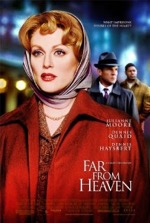
Starring: Julianne Moore
December 2002
Some heavy issues are explored in Far From Heaven, which are dealt with in a very realistic manner; no fairy tale ending here. Julianne Moore is simply astounding and Elmer Bernstein’s score perfectly captures the wistful mood of a forbidden love that can never be realized.
Rating: 2 1/2
Treasure Planet (PG)
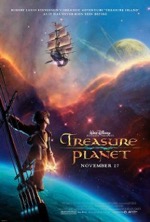
Starring: Joseph Gordon-Levitt
November 2002
Treasure Planet follows Stevenson’s classic fairly closely, but I found the infusing of this pirate epic into a sci-fi universe to be a little hard to take. The movie does have some memorable characters and some thrilling action sequences, but in the end, my opinion resembles the sounds of those speaking Flatula.
Rating: 2
Solaris (PG-13)
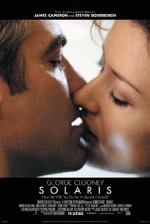
Starring: George Clooney
November 2002
It’s not often that I utterly despise a sci-fi movie, but here’s the exception. Dark, claustrophobic and static (not to mention, boring), the movie has no redeeming qualities. Solaris is pure, mind-numbing existentialism.
Rating: 1
The Emperor’s Club (PG-13)
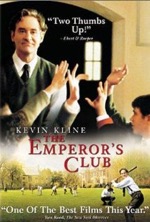
Starring: Kevin Kline
November 2002
As I walked out of the theater with a good friend of mine, he said, “Finally something with some meat.” I couldn’t have said it any better if I tried. An engaging and heart-warming story with an Oscar-worthy performance by Kevin Kline, The Emperor’s Club easily earns my highest recommendation.
Rating: 3 1/2
Die Another Day (PG-13)
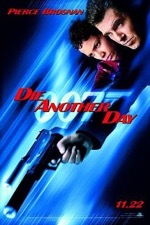
Starring: Pierce Brosnan
November 2002
As Bond films go, this is probably the cream of the crop. And yet…it’s overstuffed with unbelievable action sequences, a smattering of double entendres and the requisite one-liners so stale they leave you reaching for a Rolaid.
Rating: 2 1/2
The Ring (PG-13)
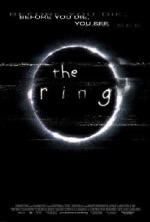
Starring: Naomi Watts
October 2002
The Ring was a disturbing film that began with a far-fetched scenario and ended with a resounding, “Huh?” Riddled with horror gimmicks and gaping plot holes, the most frightening aspect of The Ring was that it made it to the big screen.
Rating: 2
Sweet Home Alabama (PG-13)

Starring: Reese Witherspoon
September 2002
There are a lot of things about this movie that are charming, and it’s nice to see a separated couple get back together, but some crass speech, foul language and crude humor really keep me from giving Sweet Home Alabama my full recommendation.
Rating: 2 1/2
The Four Feathers (PG-13)
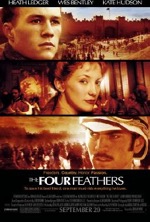
Starring: Heath Ledger
September 2002
This movie could have been so much more. Besides fudging on the history lesson, The Four Feathers failed to deliver on the emotion front. Static directing and uninspired acting add to the film’s malaise and render it mediocre at best.
Rating: 2 1/2
Signs (PG-13)
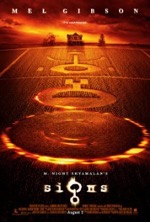
Starring: Mel Gibson
August 2002
From the writer/director/producer of The Sixth Sense, Signs is a taut thriller that delivers on its promise to keep you on the edge of your seat. Hitchcock would be proud of this effort, which harkens back to V and War of the Worlds, yet maintains its own identity. Signs has a great twist ending and a faith-affirming moral.
Rating: 3
K-19 The Widowmaker (PG-13)
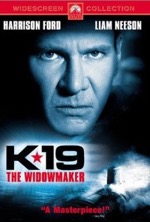
Starring: Harrison Ford
July 2002
A Cold War sub flick with Ford and Neeson is a sure-fire winner, right? Star power couldn’t keep K-19 afloat due to a plodding plot and static directing. This true story wasn’t all that entertaining and doesn’t hold a rudder to U-571.
Rating: 2
Reign of Fire (PG-13)
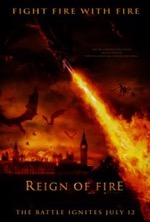
Starring: Christian Bale
July 2002
Reign of Fire is the quintessential B movie. Big names like Bale and McConaughey couldn’t salvage the banal and dragging storyline. The characters make leaps in logic that are there only to service the plot…if you can call it that.
Rating: 2
Men in Black II (PG-13)
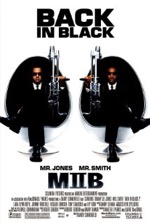
Starring: Tommy Lee Jones
July 2002
The animated short about the Chub Chubs was much more entertaining than the M.I.B. sequel, which suffered from an anemic plot and scant, if not non-existent, character development. I’d already seen the best scenes in the trailer. This one is mediocre at best.
Rating: 1 1/2
Minority Report (PG-13)
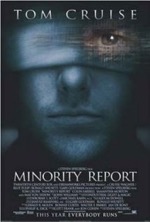
Starring: Tom Cruise
June 2002
This is the first film in 2002 to deliver on all the hype and actually offer quite a bit more. An oft-dark vision of the future, Minority Report posits the notion that you can change the future; a powerful message even without the excellent plot and eye-popping effects.
Rating: 3
Lilo & Stitch (PG)

Starring: Daveigh Chase
June 2002
Lilo & Stitch is at its best when dealing with friendship and family and at its worst when it tries to be funny and when it tries parodying Men in Black. Lilo & Stitch isn’t Disney's finest, but it’s entertaining just the same.
Rating: 2 1/2
The Bourne Identity (PG-13)
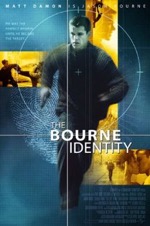
Starring: Matt Damon
June 2002
Intense from the word go, The Bourne Identity has great action (fight) sequences and plot to spare. Damon is surprisingly good in the lead role and the supporting cast is equally strong. Don’t look now, but Damon may have finally caught up to (if not surpassed) Affleck.
Rating: 3
The Sum of All Fears (PG-13)
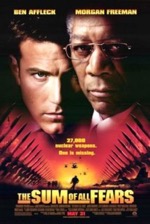
Starring: Ben Affleck
May 2002
A taut action thriller, The Sum of All Fears had a riveting set-up, but lost all credibility with its abrupt ending. Affleck and Freeman are good, but really aren’t given much to do in the film. I’m afraid it doesn’t measure up to the other “Clancy” movies.
Rating: 2 1/2
Star Wars: Episode II—Attack of the Clones (PG-13)

Starring: Ewan McGregor
May 2002
I instantly liked this movie and maintain that it’s a hyperspace jump ahead of Episode I. Christensen’s acting left me cold, but Attack of the Clones has some semblance of a plot with a couple of major twists near the end. Verdict: Better than Episode I, not nearly as good as the original trilogy.
Rating: 3
Spider-Man (PG-13)
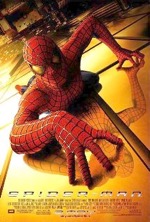
Starring: Tobey Maguire
May 2002
This is a comic adaptation that delivered. What makes Spider-Man work is its humanness. McGuire plays the title role to perfection and connects the audience to the human aspects of this super-human character. The “origin” plot was much more interesting to me than the predictable ending, however.
Rating: 3
The Rookie (G)
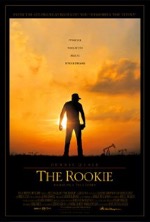
Starring: Dennis Quaid
March 2002
It’s been a long time since I’ve been in an audience that clapped at the end of the movie. It’s been a longer time since I’ve cried while watching a movie. The Rookie is simply the most inspiring movie I’ve seen in a very, very long time.
Rating: 3
Clockstoppers (PG)
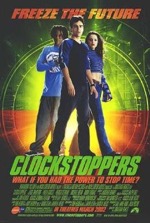
Starring: Jesse Bradford
March 2002
A little on the pedestrian side, Clockstoppers succeeds at being a first-rate teen movie that never takes itself seriously and has a lot of fun—if not campy—moments along the way. There’s nothing Oscar-worthy here, just a fun, family flick.
Rating: 2
E.T. The Extra Terrestrial - 20th Anniversary Edition (PG)
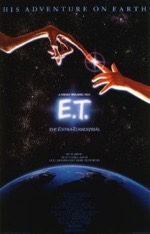
Starring: Henry Thomas
March 2002
How could I not give this movie a multitude of stars? The new scenes, though few, are nifty, and it was nice to see an innocent Drew Barrymore again; but truthfully, E.T. never did anything for me emotionally. Perhaps it’s because I first saw it when I was 29 (I know, I was born under a rock).
Rating: 3 1/2
Ice Age (PG)
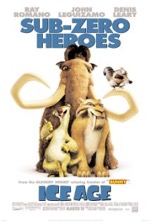
Starring: Ray Romano
March 2002
Once again proving that computer-generated tales are consistently the best movies out there (Final Fantasy excluded), Ice Age has mammoth-sized gags, a touching story and a theme of redemption that brings a tear to the eye.
Rating: 3
The Time Machine (PG-13)
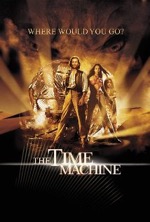
Starring: Guy Pearce
March 2002
This modern take on H. G. Wells' classic sci-fi novel has some new plot twists and a new romance, but doesn’t have the soul of the original. At the end, the time traveler may have had a promising future, but as a viewer, I had unfinished business in the past.
Rating: 2
John Q (PG-13)
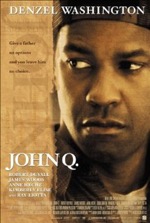
Starring: Denzel Washington
February 2002
An emotionally taut thriller, John Q is held back only by a predictable plot. Denzel Washington delivers an Oscar-worthy performance and the supporting cast is exceptional as well; especially Robert Duvall, James Woods, Anne Heche, Ray Liotta and Eddie Griffin—the “Slapaho” guy.
Rating: 3
I Am Sam (PG-13)
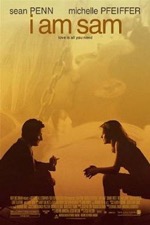
Starring: Sean Penn
January 2002
Michelle Pfeiffer is solid. Dakota Fanning is an angel. Sean Penn is sensational. The story is good; but I wasn’t overly thrilled with the ending. After two and a half hours of fairly good entertainment, I Am Sam failed to resolve to my satisfaction.
Rating: 2 1/2
The Count of Monte Cristo (PG-13)
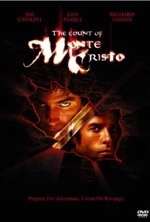
Starring: Jim Caviezel
January 2002
A faithful re-telling of Dumas’ classic novel, The Count of Monte Cristo was one of the biggest underachievers on the big screen this year. Every aspect of this film was finely crafted, and yet, it was overlooked by the Academy and millions of moviegoers alike.
Rating: 3
A Beautiful Mind (PG-13)
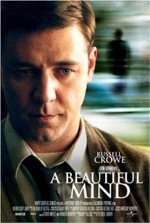
Starring: Russell Crowe
January 2002
A truly exquisite film—and would you expect any less from Ron Howard? Cerebral and convoluted (much like a brain), A Beautiful Mind is a powerful true story of love and courage, compellingly brought to life by Crowe and Connelly.
Rating: 3 1/2
The Lord of the Rings: The Fellowship of the Ring (PG-13)
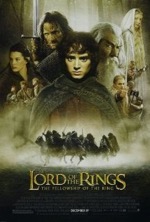
Starring: Elijah Wood
December 2001
Enchanting. Spellbinding. This is simply one of the most amazing, moving and magical movies I’ve ever seen. The Fellowship of the Ring excels in every category (acting, directing, music, etc.) and leaves you craving a sequel. My vote for movie of the year.
Rating: 4
Ocean’s Eleven (PG-13)
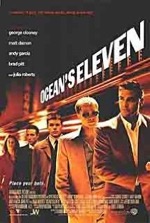
Starring: George Clooney
December 2001
Once Ocean's Eleven gets going, it’s an amusing, star-studded romp that depicts a daring heist in a major Vegas casino. The plot never tips its hand fully until the end, and the final series of twists is quite good.
Rating: 3
K-PAX (PG-13)
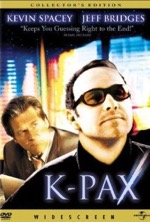
Starring: Kevin Spacey
October 2001
K-PAX is a slightly off-kilter movie that's enjoyable just for that reason. Bridges and Spacey deliver fine performances and the plot is engaging enough to keep you guessing until the emotional climax. The message K-PAX leaves you with is powerfully poignant.
Rating: 3
Serendipity (PG-13)
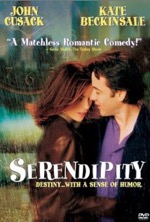
Starring: John Cusack
October 2001
A slightly better than average love story, Serendipity works because the romantic leads have great chemistry and because of the fateful book that reunites them. John Cusack and Kate Beckinsale are supported by some great performances by Jeremy Piven, Molly Shannon and Bridget Moynahan. The snow angel on ice scene stands out as one of the most memorable in the movie.
Rating: 2 1/2
The Musketeer (PG-13)
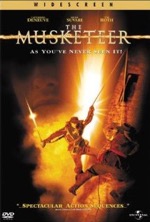
Starring: Justin Chambers
September 2001
I was pleasantly surprised by this one. The Musketeer has a halfway decent storyline, action sequences that stay just inside the boundaries of believability and boasts the best villain I've seen this year. The set design is Oscar-worthy.
Rating: 2 1/2
Planet of the Apes (PG-13)
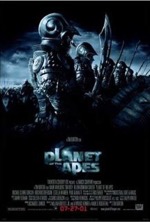
Starring: Mark Wahlberg
July 2001
This new Planet of the Apes doesn't have it all, but it has enough engaging elements to make me recommend it. Character development is predictably weak, but the plot is surprisingly solid and kept me guessing right up to the final, fateful twist.
Rating: 2 1/2
Jurassic Park III (PG-13)
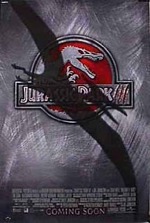
Starring: Sam Neill
July 2001
Great special effects, good directing, fair acting, weak plot and poor character development equals a mediocre sequel. Jurassic Park III is a T-Rex leap better than the previous film, The Lost World, and yet it didn't make me jump. Nothing new here.
Rating: 2 1/2
Final Fantasy: The Spirits Within (PG-13)
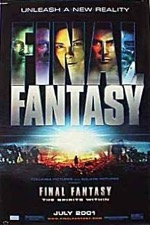
Starring: Ming-Na Wen
July 2001
The subtitle, The Spirits Within, says it all. Gia (Mother Earth) and the eight living spirits? What kind of New Age schlock is this? Maybe it's fitting that this flick marks an "evolutionary" leap in computer-generated movies.
Rating: 1 1/2
Cats & Dogs (PG)
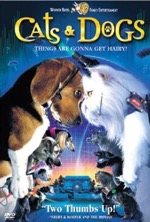
Starring: Jeff Goldblum
July 2001
After suspending my disbelief, I found this to be a rather humorous look at the age-old battle for supremacy between felines and canines; kicked up a notch. A talking animal picture that entertains and bolsters family values is okay by me.
Rating: 2
A.I. Artificial Intelligence (PG-13)
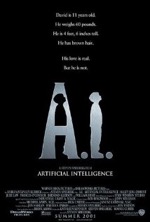
Starring: Haley Joel Osment
June 2001
Two diametrically opposed directing styles collide in A.I., producing a moody, avant-garde film. Every aspect of the movie soars except for the story, which makes the movie memorable for its unfulfilled potential. Osmet is a gem.
Rating: 2 1/2
Lara Croft: Tomb Raider (PG-13)
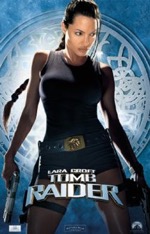
Starring: Angelina Jolie
June 2001
The problem with so many modern movies? Great special effects mated with anemic plots. This movie is no exception, and adds bad taste to the mix; gratuitous scenes reveal the true star of the movie...Jolie's physique.
Rating: 1 1/2
Atlantis: The Lost Empire (PG)
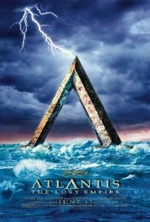
Starring: Michael J. Fox
June 2001
Sharp animation, good voice talents and memorable characters almost make me give Atlantis a solid recommendation. Thinly-veiled New Age philosophies and violence (people actually die in this Disney movie) make me think twice about doing so.
Rating: 2 1/2
Evolution (PG-13)
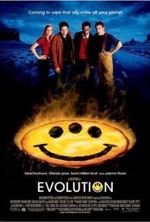
Starring: David Duchovny
June 2001
Phil Tippet’s unique creatures and solid acting performances by David Duchovny and Julianne Moore couldn’t bring Evolution past a primordial stage. You might even be disappointed paying the matinee price for this one.
Rating: 1 1/2
Shrek (PG)
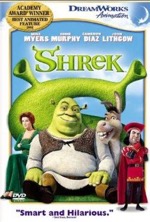
Starring: Mike Myers
May 2001
A genuinely hilarious adventure, Shrek is a fairy tale that delivers. Great voice talents, amazing CGI and a heart-warming plot make Shrek the feel-good movie of the summer.
Rating: 3
A Knight's Tale (PG-13)
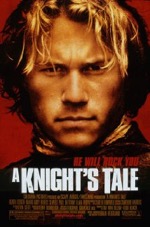
Starring: Heath Ledger
May 2001
Brief nudity and innumerable anachronisms (most notably the score) nearly ground this medieval tale, but a serviceable storyline, colorful sidekicks and an adequate villain combine to produce a satisfying and inspiring film.
Rating: 2 1/2
The Mummy Returns (PG-13)
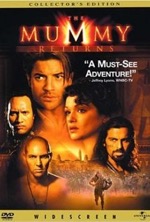
Starring: Brendan Fraser
May 2001
Great special effects can’t compensate for a contrived plot. Little originality, excessive violence, grotesque creatures and a reincarnation subplot make this a mediocre movie at best.
Rating: 2
Crocodile Dundee in Los Angeles (PG)
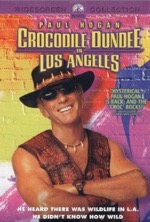
Starring: Paul Hogan
April 2001
This, third, Crocodile Dundee movie is one sequel that should not have been made—it’s a terrible waste, mate. Paul Hogan’s jokes land like anvils and the story is as pedestrian as heck. This is the prime example of returning to a dry well. The Mike Tyson scene is silly as is the skunk rescue sequence. The only remotely funny moment in the film is at the posh Hollywood party where Dundee regales humorous episodes with his good friend “Mal” Gibson.
Rating: 2
Finding Forrester (PG-13)
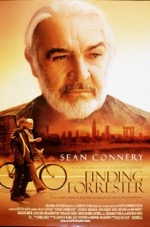
Starring: Sean Connery
January 2001
Sean Connery plays agoraphobic William Forrester, renowned author of two best-selling novels, who entered seclusion at the height of his success and now exists as a curmudgeonly recluse in the Bronx. Enter Jamal Wallace (Rob Brown), a gifted writer who Forrester reluctantly takes under his wing (after the teen breaks into his apartment on a dare), teaching him the finer points of how to craft the Great American Novel. Jamal’s impressive grades pave the way for him to attend an upper crust school, where he makes friends with Claire Spence (Anna Paquin), but one of his teachers, Prof. Henry Crawford (F. Murray Abraham) has it in for him, claiming the young African American student is plagiarizing other famous works. The climactic scene, where Forrester visits Jamal’s class and reads one of his protégée’s works, is the moment of the film, very gratifying. There’s nothing revolutionary about Finding Forrester, but as a character study and a tale of self-discovery and friendship, the movie passes with flying colors.
Rating: 3
Miss Congeniality (PG-13)
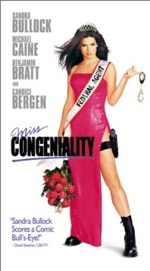
December 2000
An amusing fish-out-of-water tale, Miss Congeniality is a feel good hit that’s an undisputed success thanks to the excellent script and memorable performances. Sandra Bullock’s character is a “tough girl” detective who must go undercover as a beauty pageant contestant in order to bust the bad guy. Swishy Michael Caine is hired to transform the tomboy into a fashion model, and his ongoing failed attempts at making Bullock more feminine are hilariously enjoyable. Candace Bergen plays the controlling pageant organizer and William Shatner is a hoot as the cheese ball emcee. Benjamin Bratt is the love interest; one of his scenes with Bullock prompts the movie’s most quotable section, “You think I’m gorgeous…you want to kiss me.” Miss Congeniality is no runner up, though the runner up in the movie, Miss Texas, had my vote.
Rating: 3
Cast Away (PG-13)
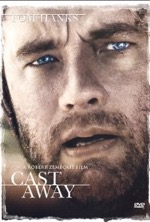
Starring: Tom Hanks
December 2000
Tom Hanks, again, proves he’s one of Hollywood’s finest actors. Just like he did for Philadelphia, Hanks emaciated himself for the island scenes. An enormous amount of screen time is spent on Hanks’ survival lessons, and it’s a tribute to his acting and Zemeckis’ skillful directing that our interest is held for so long. Hanks’ conversations with Wilson get annoying after a while, but the anthropomorphized volleyball is a mental defense mechanism that, in tandem with his hope of being reunited with his sweetheart, Kelly (Helen Hunt), is the only thing that keeps him sane. His reunion with Kelly after his rescue is a study in ambivalence: he still loves her but realizes he must move on, just as she did. Other than the unsatisfactory existential coda, Cast Away is an excellent drama that speaks volumes even when dialogue is scarce.
Rating: 3
Unbreakable (PG-13)
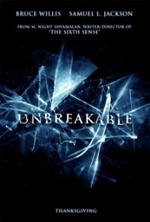
Starring: Bruce Willis
November 2000
David Dunn (Bruce Willis) has never been sick, never broken a bone and has walked away from a train wreck where he was the sole survivor. Elijah Price (Samuel L. Jackson) is the fragile art collector who tests Dunn’s special abilities and, in the process, discovers his own true nature. Despite an intriguing premise, forensic-level direction by M. Night Shyamalan and a wonderfully nuanced performance by Willis, the movie topples like a stack of comic books near the climax, when the auteur unleashes his unconventional, twist ending. There’s no doubting the movie’s status as a fine film, but it doesn’t take a sixth sense to divine that this second Shyamalan thrill-fest isn’t as good as the first.
Rating: 3
Mercy Streets (PG-13)
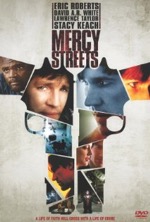
Starring: Eric Roberts
October 2000
A low-budget affair that tells a decent story despite its monetary restrictions, Mercy Streets is a religious film that doesn’t pound you over the head with its moral lesson, but rather, shows real people in real-life situations. David White, in a dual role, does a good job of playing the “good brother, bad brother” scenario: wayward John, pressured into doing “one last job” for nefarious Rome (Eric Roberts), accidentally trades places with his priest brother, Jeremiah, who ends up taking the rap for John. Excellent guest performances by Cynthia Watros (The Drew Carey Show), Stacy Keach and even Lawrence Taylor salvage the movie from the typical B movie slag-heap. The “anatomy of a heist” sequence is brilliant, especially the freeze-frame shot, but the final scene is nearly identical to the dénouement in Ocean’s Eleven.
Rating: 2 1/2
Meet the Parents (PG-13)
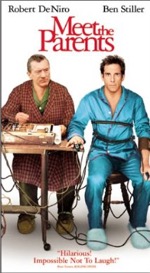
Starring: Robert DeNiro
October 2000
A far less controversial and far more whimsical riff on Guess Who’s Coming to Dinner (1967), Meet the Parents is really just an elaborate Murphy’s Law scenario where events exponentially worsen each time Gaylord “Greg” Focker (Ben Stiller) attempts to impress his future in-laws. Greg’s fiancée, Pam (Teri Polo), tries running interference for him with her prim and proper mom, Dina (Blythe Danner) and eagle-eyed dad, Jack (Robert DeNiro), but Pam’s peacekeeping efforts are no match for Greg’s uncanny ability to stumble into misfortune. It’s normal for fathers to view prospective son-in-laws with apprehension or distrust, but Jack takes that paternal instinct to new extremes; as an ex-C.I.A. operative, Jack uses high-tech equipment to spy on Greg and later, interrogate him.
There’s no shortage of amusing scenes in the movie; like when Greg accidentally topples an urn containing the ashes of Jack’s mom, or the “Puff the Magic Dragon” conversation between Jack and Greg, or when Greg accidentally ignites the wedding gazebo, handcrafted by Pam’s ex-, Kevin (Owen Wilson), or when Greg, thinking he’s killed the family cat, Jinx, tries to pass off a painted stray for the genuine article—the faux Jinx demolishes the house while the family is at dinner. After an hour or so, however; these escalating incidents, though useful in generating sympathy for Greg, start to challenge the boundaries of believability—by the end, feelings of exhaustion set in and you just wish the guy would either escape the vicious circle of gaffes and mishaps or just be put out of his misery.
Director Jay Roach (Austin Powers) does a good job of utilizing the considerable talent at his disposal. Ben Stiller, son of legendary comedian Jerry Stiller, is known for his slapstick sense of humor so his performance, to some degree, is predictable. The real surprise here is DeNiro, whose deadpan delivery almost seems incongruous with his typical “tough guy” persona. No one will ever confuse DeNiro with a comedian, but he’s quite humorous as the paranoid, overprotective father who uses Greg’s last name as an expletive and repeatedly cudgels Greg over the head with his familial “circle of trust” philosophy. “I’m watching you,” Jack warns Greg, and you can’t help but feel sorry for the guy. What a nightmare!
Meet the Parents is the worst case scenario of a young man desperately trying, yet repeatedly failing, to please his fiancée’s family. Here’s hoping none of us will ever have to experience the embarrassment, humiliation and mental angst endured by that poor, misunderstood and tortured soul…Gaylord Focker.
Rating: 2 1/2
Remember the Titans (PG-13)
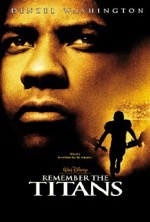
Starring: Denzel Washington
September 2000
On his impressively long list of career-defining roles, Denzel Washington’s turn as football head coach Boone, of newly-integrated T.C. Williams High School in Virginia during the early seventies, stands out as one of his very best. Remember the Titans is so much more than a sports movie and even transcends its poignant social commentary…the movie is fun and the characters are memorable. There are many standout scenes, including: the team’s pre-dawn jog to Gettysburg, Gary Bertier’s ill-fated drive and, of course, the championship game. Remember the Titans is a winner on many different levels.
Rating: 3
What Lies Beneath (PG-13)

Starring: Harrison Ford
July 2000
Just this side of a horror film, What Lies Beneath is a thriller wrapped in a mystery. The movie is brimming with spine-tingling scenes that make you want to jump out of your skin. Though a radical departure from the director’s staple, Robert Zemeckis does a fine job of building suspense and waiting until the perfect moment to have a door slam, a picture frame fall or a corpse appear in the bath tub (easily the freakiest transformation I’ve witnessed in a very long time). Michelle Pfeiffer delivers the most convincing performance I’ve seen this year and Harrison Ford keeps you guessing which side he’s on until the bitter, fateful end. What Lies Beneath is a finely crafted tale of dark secrets and hidden transgressions, presented with harrowing intensity.
Rating: 3
The Kid (PG)
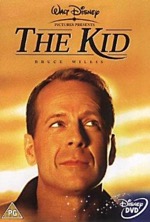
Starring: Bruce Willis
July 2000
A modern twist on Dickens' A Christmas Carol, the movie introduces egotistical image consultant, Russ (Bruce Willis) to a 10 year-old version of himself. Dealing with the obnoxious nature of his younger, chunkier self brings Russ to a place of discovery and goads him into making positive choices for the future. A bit saccharine in spots, Disney’s The Kid is heart-warming and features a fine performance by Willis.
Rating: 2 1/2
The Perfect Storm (PG-13)
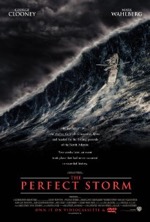
Starring: George Clooney
June 2000
Based on actual events, The Perfect Storm is a glimpse into the hard lives of Atlantic fisherman and the toll the job takes on them and their spouses. George Clooney is good, but not great, and the end is easy to predict. Perhaps taking a little artistic license would have improved the straightforward storyline.
Rating: 2 1/2
Chicken Run (G)
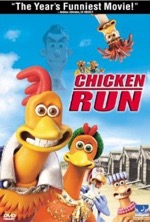
Starring: Mel Gibson
June 2000
From the director of the Oscar-winning shorts, Wallace & Gromit (Nick Park), comes Chicken Run, a claymation extravaganza starring the voices of Julia Sawahla, Miranda Richardson and Mel Gibson as an American chicken trapped in a British farmyard. Part Animal Farm, part The Great Escape, Chicken Run is full-on comedy that follows the madcap misadventures of Rocky (Gibson) and a group of aimless chickens as they hatch one hardboiled escape plan after the next. The heckling weasels are hilarious as is the flight training sequence, but the laughs really start rolling when the potpie machine becomes operational and when the chickens make a final, frenzied flight to freedom. Chicken Run is clever and witty…perhaps too slick for its own good. Some of the British humor goes right over the heads of American audiences and the uninterrupted torrent of jokes and gags actually detracts from the movie’s overall impact…every once in a while we need a breather. Chicken Run is a bit of a conundrum: it’s wildly entertaining, yet instantly forgettable.
Rating: 2 1/2
Titan A.E. (PG)
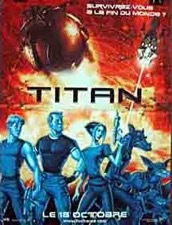
Starring: Matt Damon
June 2000
The science is appalling in this animated sci-fi flick, but the creativity is quite high—I especially liked the planet with hydrogen trees and the chase through the ice field. Ultimately, Titan A.E. fails to entertain even with the aid of stellar voice talents like Matt Damon, Bill Pullman, Drew Barrymore and Nathan Lane.
Rating: 2
Mission: Impossible 2 (PG-13)
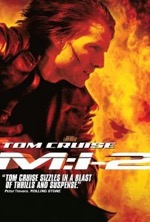
Starring: Tom Cruise
May 2000
This is the biggest disappointment of the year. The first Mission Impossible was a fine yarn with great performances. Tom Cruise is back again (on cruise control) and Anthony Hopkins makes a brief appearance, but the storyline is mediocre, at best. The face disguise gag is employed way too often and the Matrix-style bike chase and ensuing melee are nothing more than a glorified 80’s action TV show ending. And how about the scene where Cruise hangs onto a cliff with one hand? The only thing impossible in this movie is its believability.
Rating: 2
Dinosaur (PG)
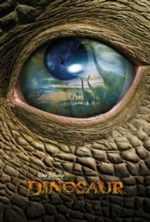
Starring: D.B. Sweeney
May 2000
I was blown away by the trailer but was less impressed with the actual movie. The latest in a long line of “mass exodus at the onset of the ice age” dino. movies, Dinosaur has a run of the mill story, but boasts startling, photo-realistic animation. D.B. Sweeny voices lead character, Aladar the Iguanodon, and Della Reese takes a memorable turn as a matronly Styrachosaur. Kids will love it…adults, maybe not so much.
Rating: 2 1/2
Frequency (PG-13)
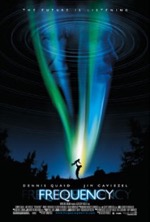
Starring: Dennis Quaid
April 2000
What a great movie! Frequency has a riveting, pulse-pounding plot and excellent performances by Dennis Quaid and James Caviezel as a father and son duo separated by time, but mysteriously connected by a HAM radio. Every time they alter history, a new set of variables come into play, creating more problems and ratcheting up the tension. This Murphy’s Law scenario is wildly entertaining—if not a bit far-fetched—and the ending twist makes you want to stand and applaud. The most enjoyable movie I’ve seen this year.
Rating: 3
U-571 (PG-13)
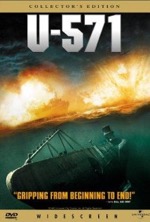
Starring: Matthew McConaughey
April 2000
Life imitates art in U-571: just as First Officer Tyler comes into his own, so does Matthew McConaughey as a leading man. The story is rife with leadership lessons, both good and bad, and the pulse-pounding plot makes for a first-rate submarine warfare flick. Though it borrows (quite heavily at times) from Run Silent, Run Deep and Crimson Tide, the movie presents intense battle sequences and really hits the mark with Tyler’s baptism of fire after his field promotion to captain. Featuring great performances from Bill Paxton, Harvey Keitel, David Keith and even Jon Bon Jovi, U-571 is a rousing and patriotic tribute to WWII soldiers.
Rating: 3
Snow Day (PG)
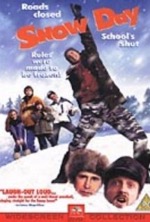
Starring: Chris Elliott
February 2000
What I thought was going to be a Chevy Chase vehicle picture turned out to be a slogging B movie—Chase’s presence, as the zany weatherman, is barely felt in the snowbound comedy. About the only thing that works in the movie (other than Chris Elliot’s annoying snowplow) is the refreshingly romantic subplot. I say refreshing because it’s not the typical “guy overcomes hardships to get the girl” scenario. Here, Hal (Mark Webber) is desperately in love with high school hottie, Claire (Emanuelle Chriqui), but after constant rejection by Claire, Hal realizes that his gal pal, Lane (Schuyler Fisk), is the better choice and a budding romance ensues. Cheesy? You bet, but Snow Day is a harmless shovel-full of slapstick fun that’s an appropriate diversion if you’re snowed in and have nothing else to do.
Rating: 2
Galaxy Quest (PG)
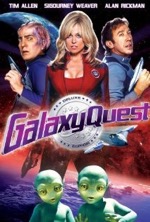
Starring: Tim Allen
December 1999
This good-natured spoof of Star Trek (specifically) and other sci-fi shows (generally) is a laugh-a-minute thrill ride that avoids ruffling the feathers of hard-core fans by never taking itself seriously. Tim Allen is flawless as Commander Taggart…he has Shatner’s strut and swagger down to a tee. In a memorable turn, Sigourney Weaver plays Lt. Tawny Madison, the communications officer who relays orders to the crew by repeating, verbatim, everything Taggart says…it’s her one job and she does it well. Tony Shaloub is absolutely hilarious as the incompetent engineer, Tech Sergeant Chen, and Sam Rockwell’s character, a no-name security officer who was killed off in Episode #81, is an obvious poke at Star Trek’s predilection for hurling red-shirted crewmen into harm’s way. Alan Rickman, as the Spock-like alien, Dr. Lazarus, paints the perfect picture of a once-serious actor who’s been typecast by legions of fans who clamor for him to recite his famous line: “By Gramthar’s Hammer…You Shall Be Avenged!” An exaggerated look at fandom and sci-fi conventions, Galaxy Quest features colorful characters, witty dialogue and excellent special effects: this is one exciting romp through outer space.
Rating: 3
Bicentennial Man (PG)
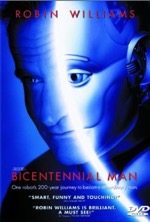
Starring: Robin Williams
December 1999
Bicentennial Man is a touching tale, which chronicles the decades-spanning journey of a robot in his quest to become human. Based on a story by Isaac Asimov and played to perfection by Robin Williams, the movie’s only downside is that it runs about twenty minutes too long. Sam Neill, Oliver Platt and Embeth Davidtz contribute excellent supporting performances.
Rating: 2 1/2